The chocolate Easter cheesecake cookies are super special and look beautiful - like little Easter nests!
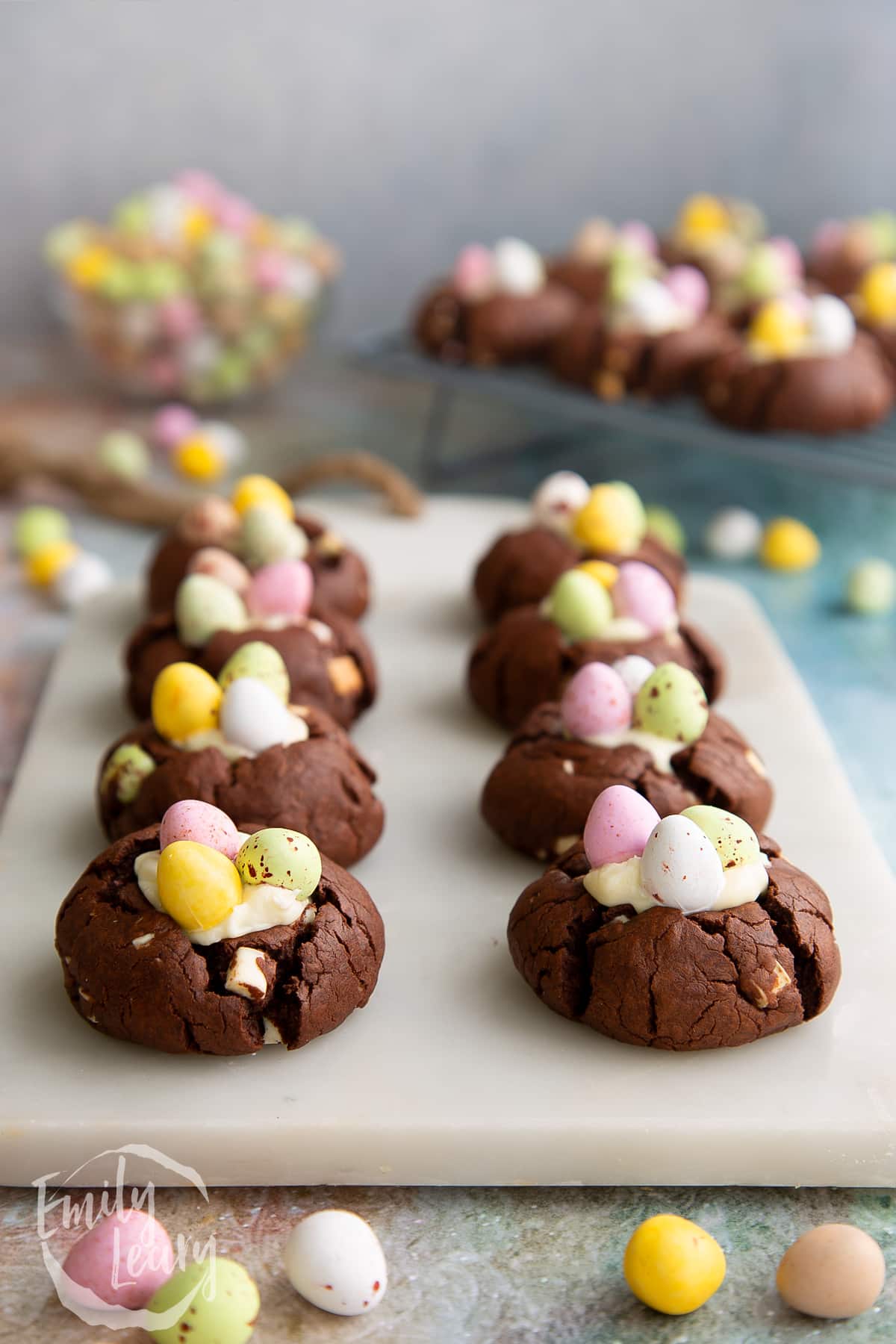
A rich, melt-in the-mouth chocolate crumb is studded with white chocolate and mini eggs, baked, then topped with white chocolate cheesecake and more mini eggs to create pretty, delicious little Easter nests!
The dough for these cookies is really easy to make in a single bowl. You'll simply whisk butter, cream cheese and sugar together, whisk in an egg and melted milk chocolate, then fold in flour, bicarbonate of soda, baking powder, salt and cocoa powder.
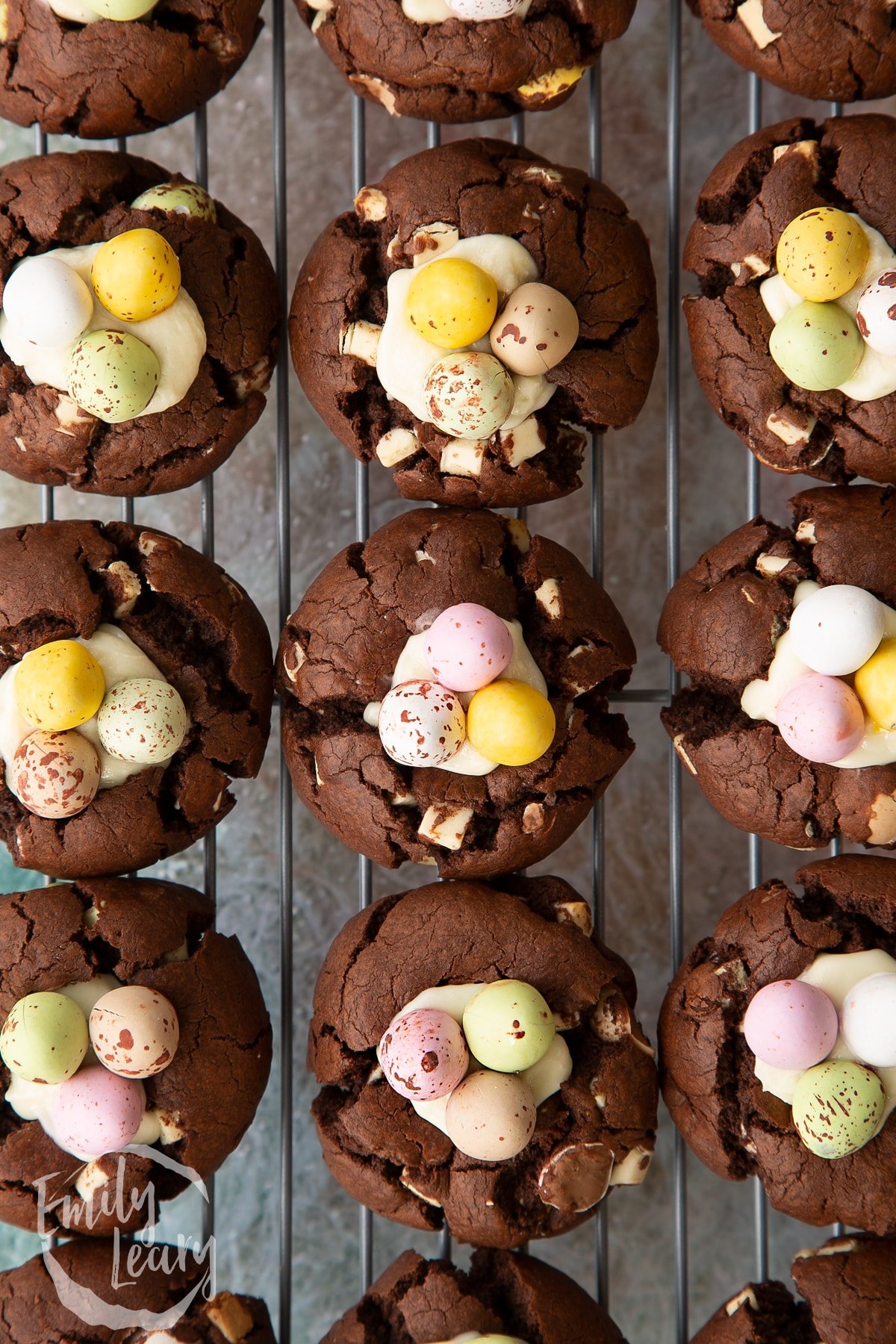
To give this beautiful dough some Easter-themed texture, you'll then fold in white chocolate chips and crushed mini eggs, then roll the dough into balls and bake!
Once they're out of the oven, you'll fill the centre of each cookie with a really simple cheesecake mixture made from melted white chocolate and cream cheese, then top with more mini eggs and leave to cool.
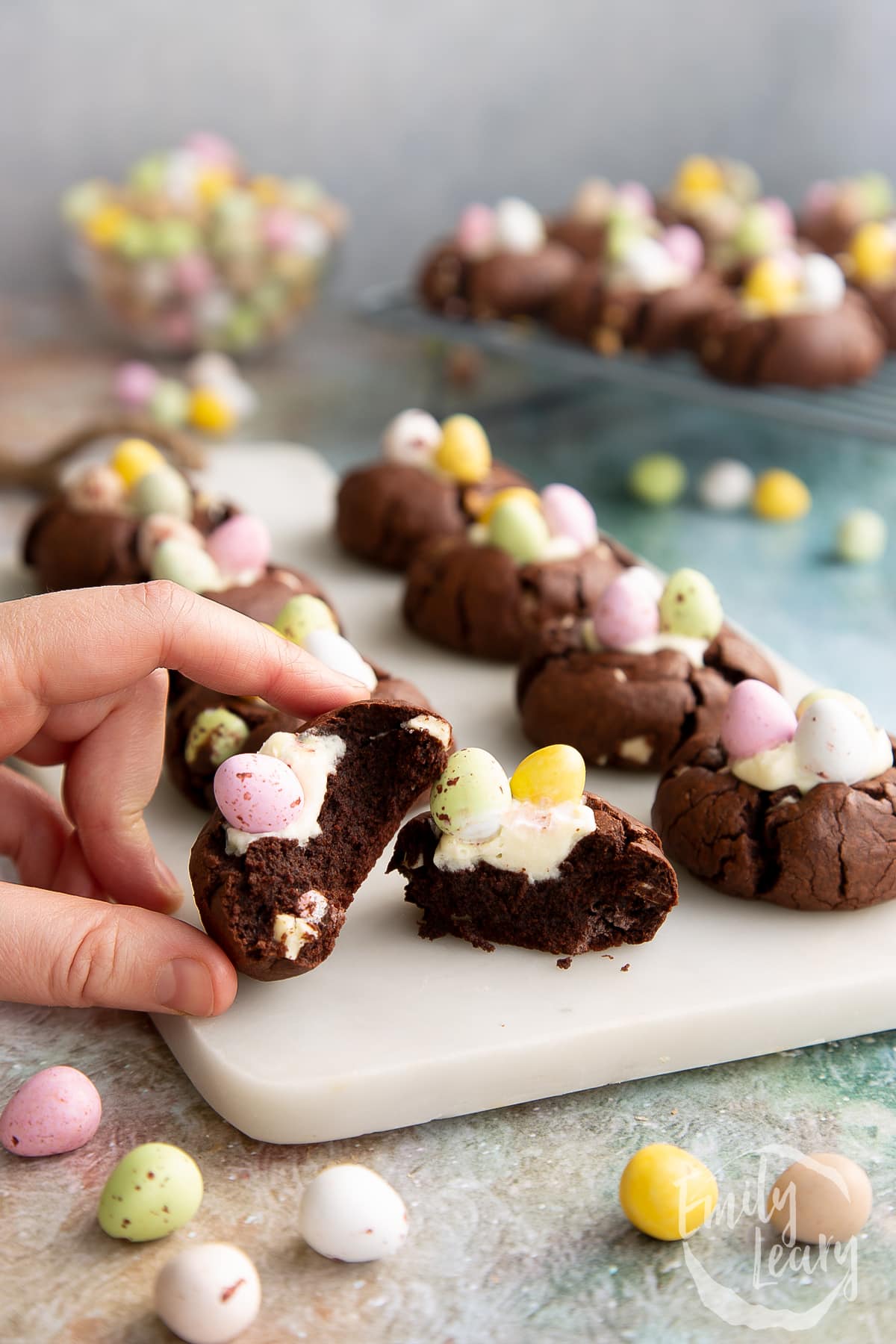
The result is just so pretty and so pleasingly delicious with its range of smooth, soft, crunchy and cool textures, the whole family is sure to love the Easter cheesecake cookies.
Here's the full recipe, complete with lots of step-by-step pics to help you along the way.
Ingredients
For the cookie dough
- 75 g (⅓ cup) full fat cream cheese
- 50 g (½ stick) salted butter softened
- 150 g (⅓ + ½ cup) white caster sugar (superfine sugar)
- 160 g (5.5 oz) dark chocolate (bittersweet) melted
- 1 medium free range eggs
- 225 g (1½ cups + 1 tbsp) plain white flour (all purpose flour)
- ½ tsp bicarbonate of soda (baking soda)
- ½ tsp baking powder
- Pinch salt
- 30 g (¼ cup) cocoa powder (dutch processed)
- 100 g (3.5 oz) Mini Cadbury Creme Eggs
For the topping
- 100 g (⅓ cup + 2 tbsp) full fat cream cheese
- 100 g (3.5 oz) white chocolate melted
- 120 g (4 oz) Mini Cadbury Creme Eggs
Equipment
Instructions
Make the dough
Preheat the oven to 180C (160C fan) and line two large baking sheets.
Melt the dark chocolate and set aside to cool.
Put the softened butter and cream cheese in a bowl.
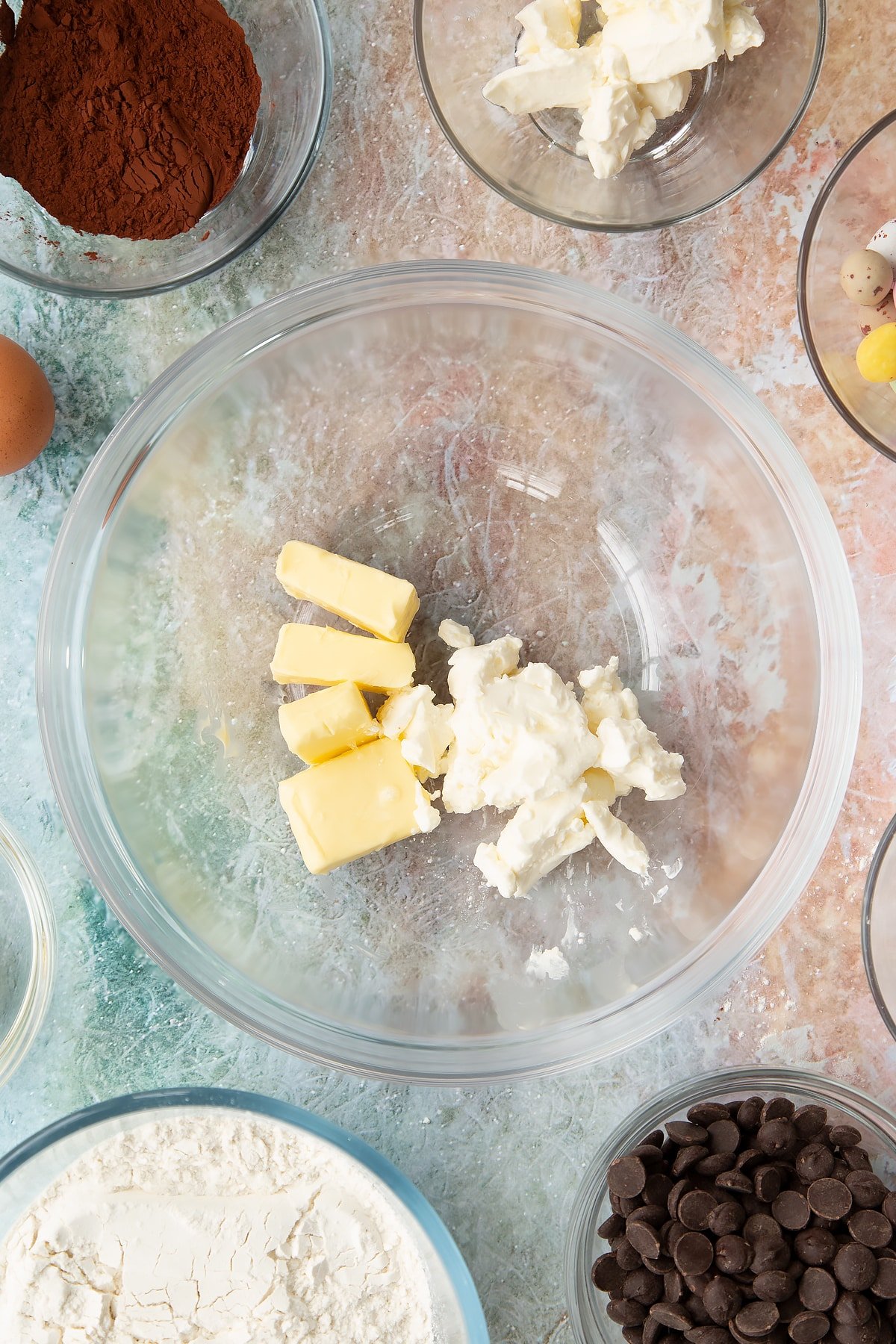
Beat together until smooth and combined.
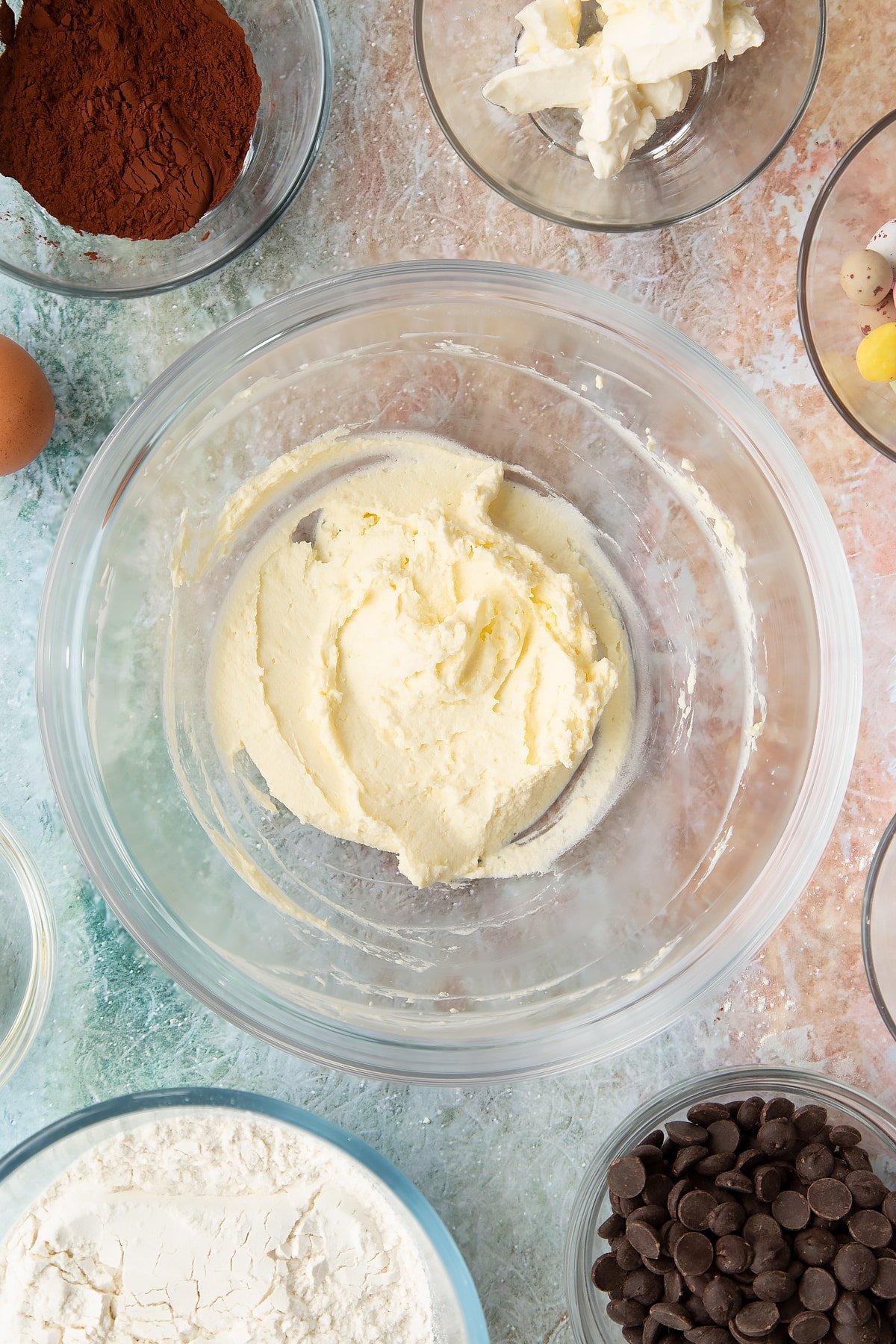
Add the sugar.
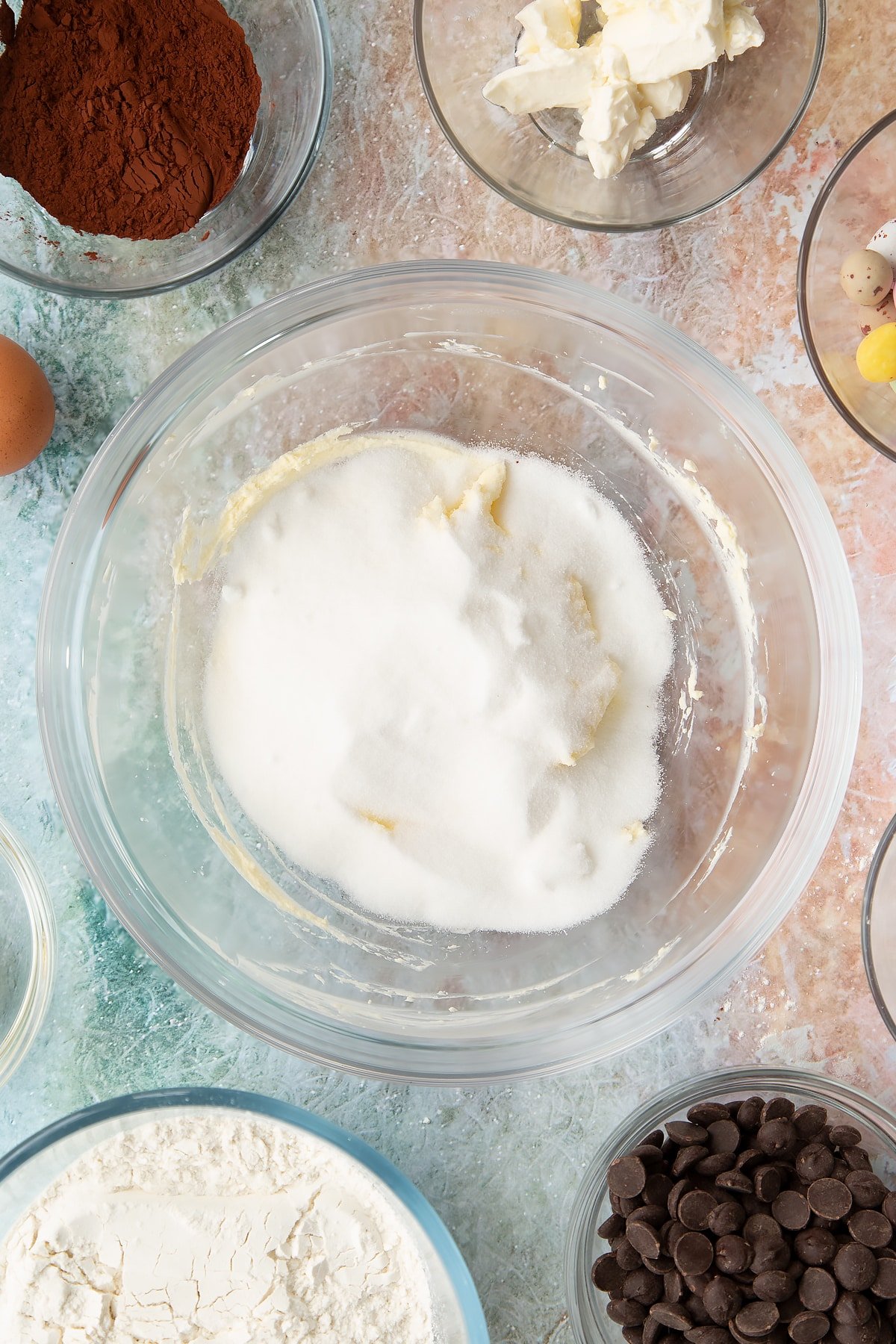
Whisk together until pale and fluffy.
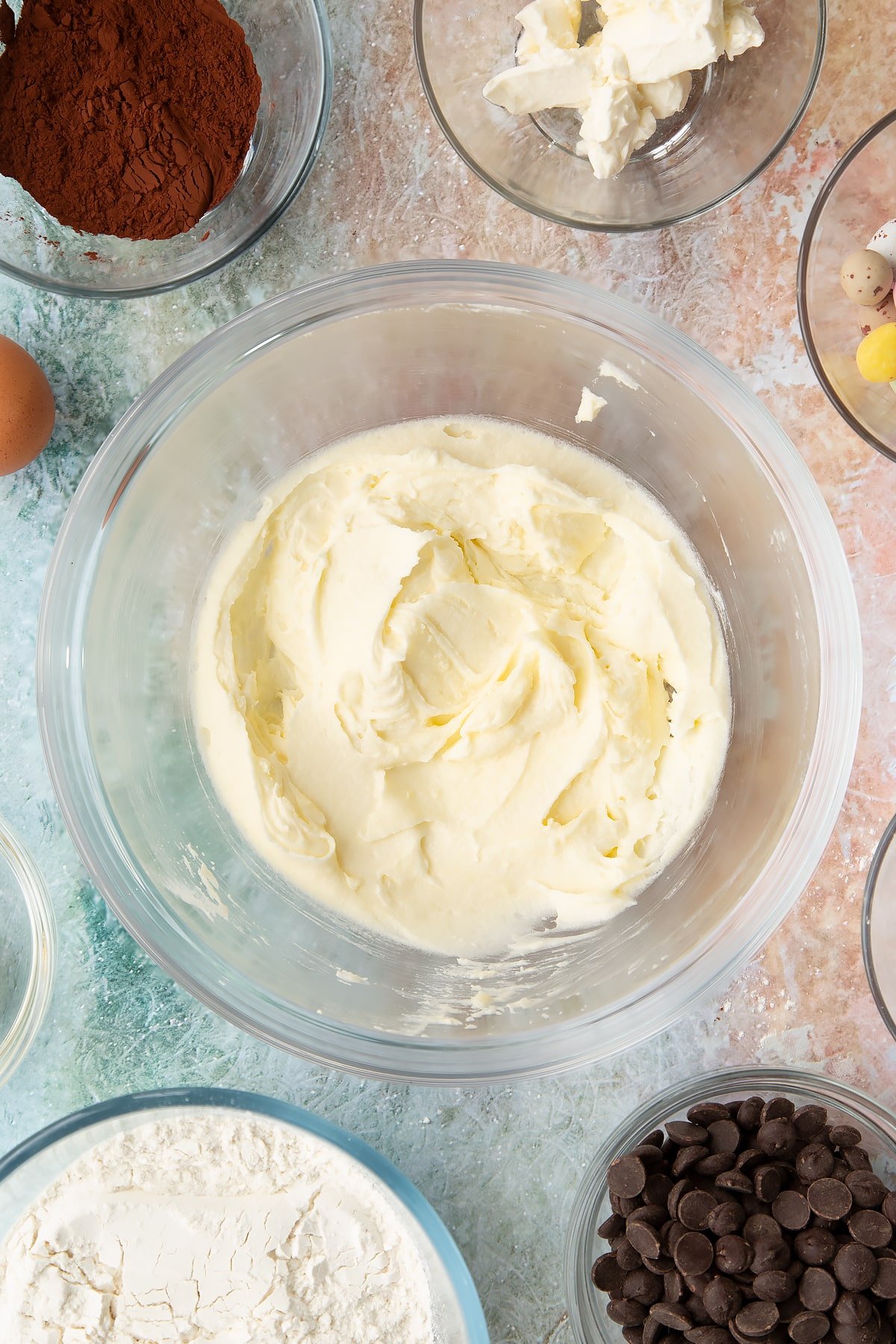
Add the egg.
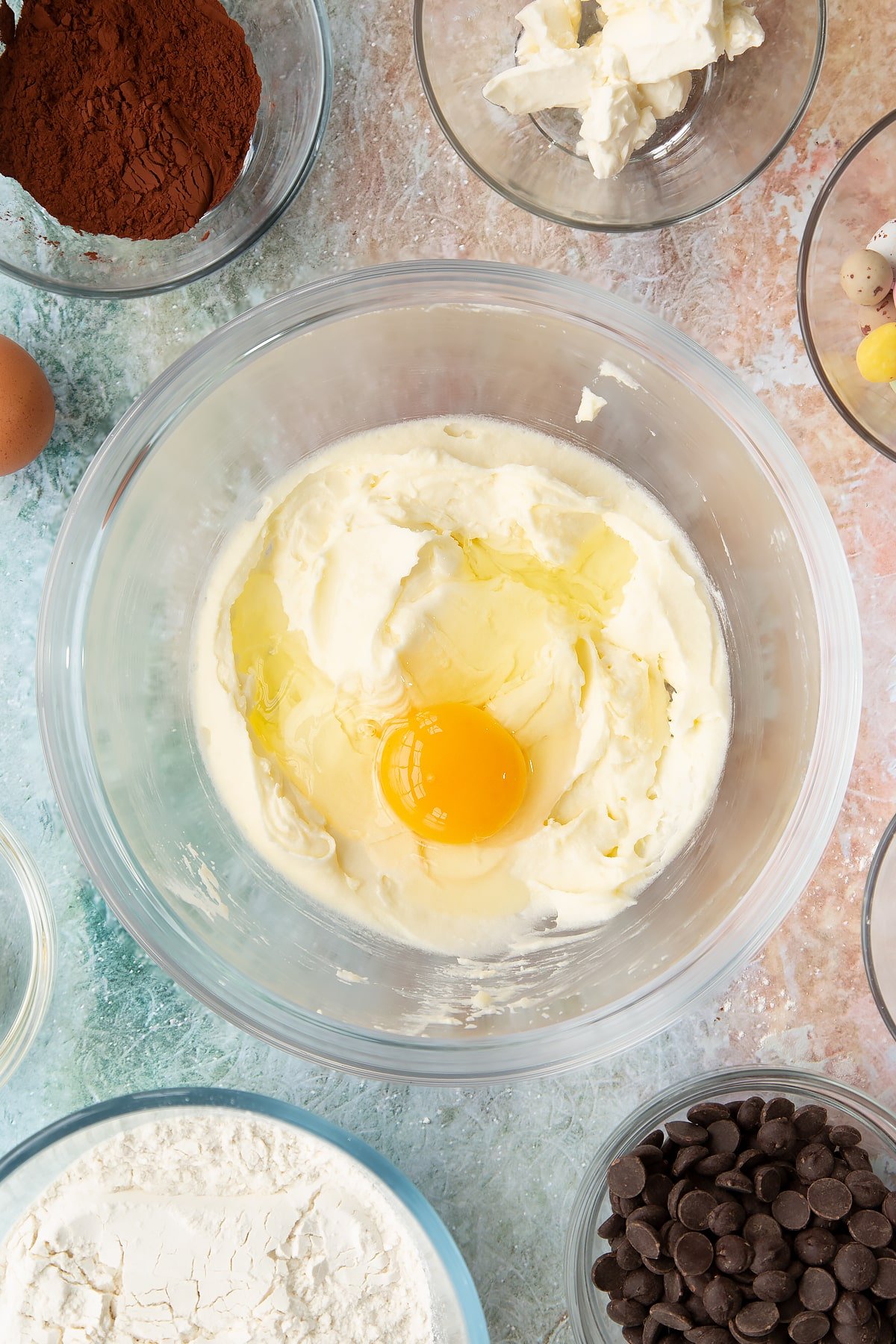
Whisk again, then add the cooled melted chocolate.
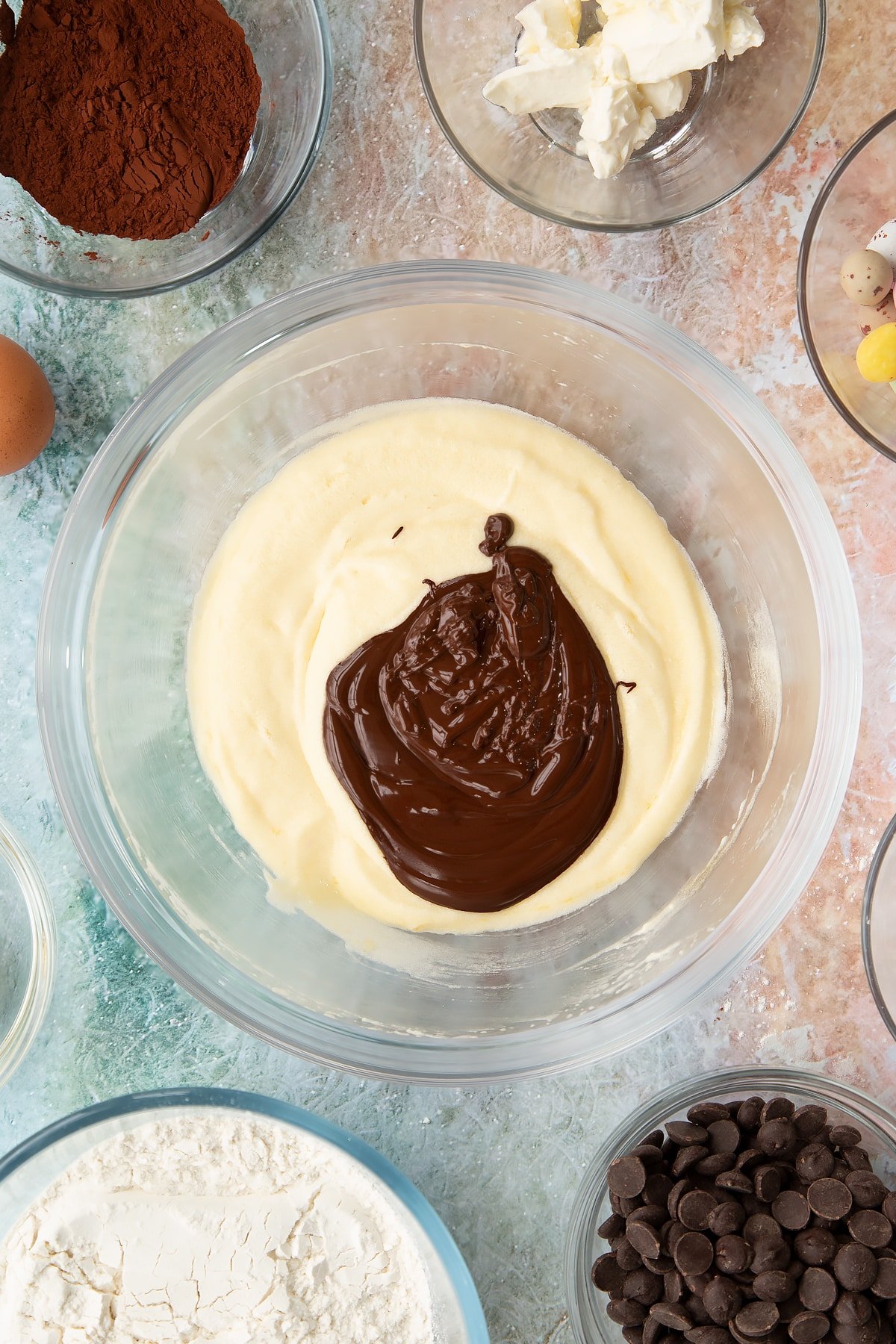
Whisk to combine.
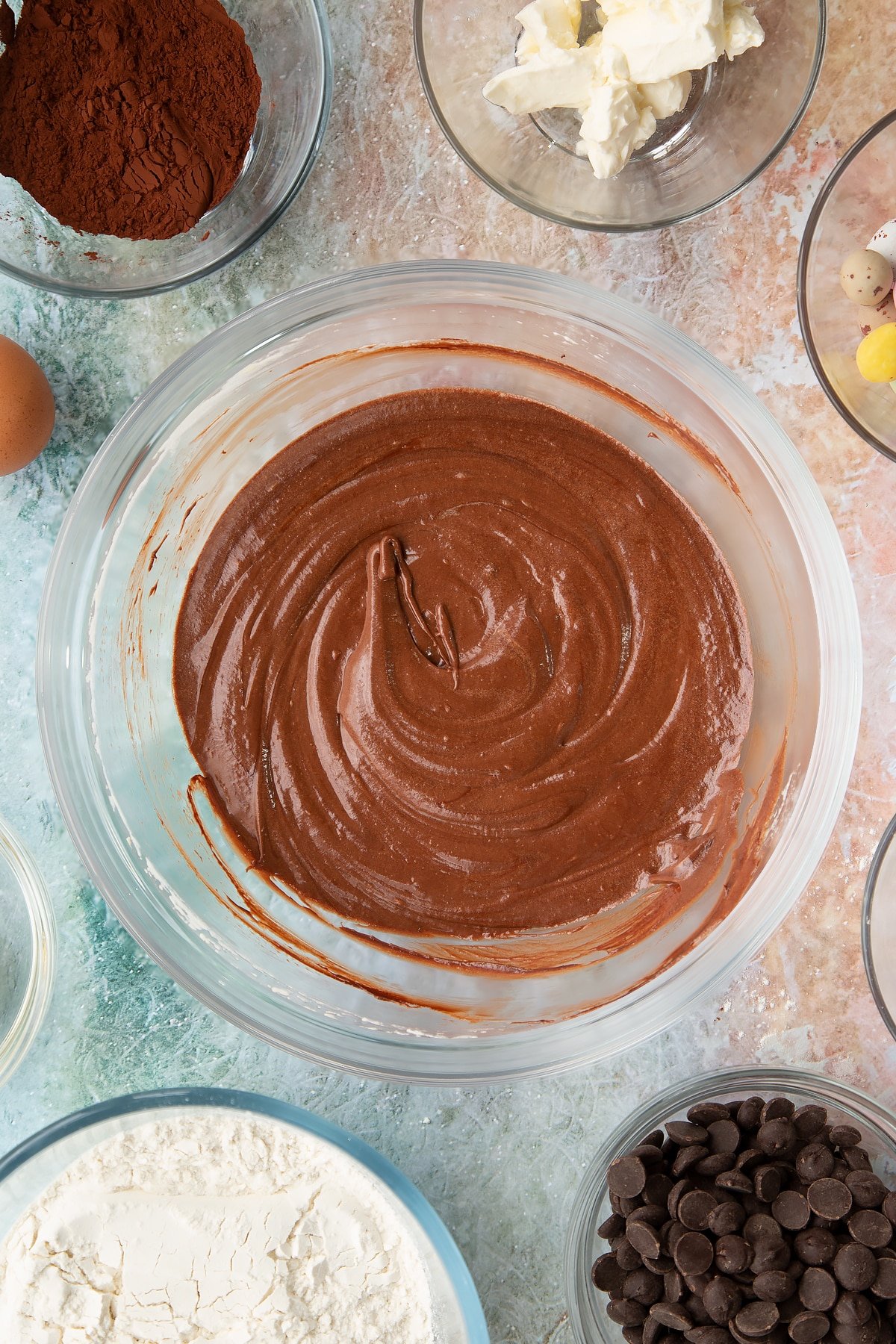
Sift in the flour, bicarbonate of soda, baking powder, salt and cocoa powder.
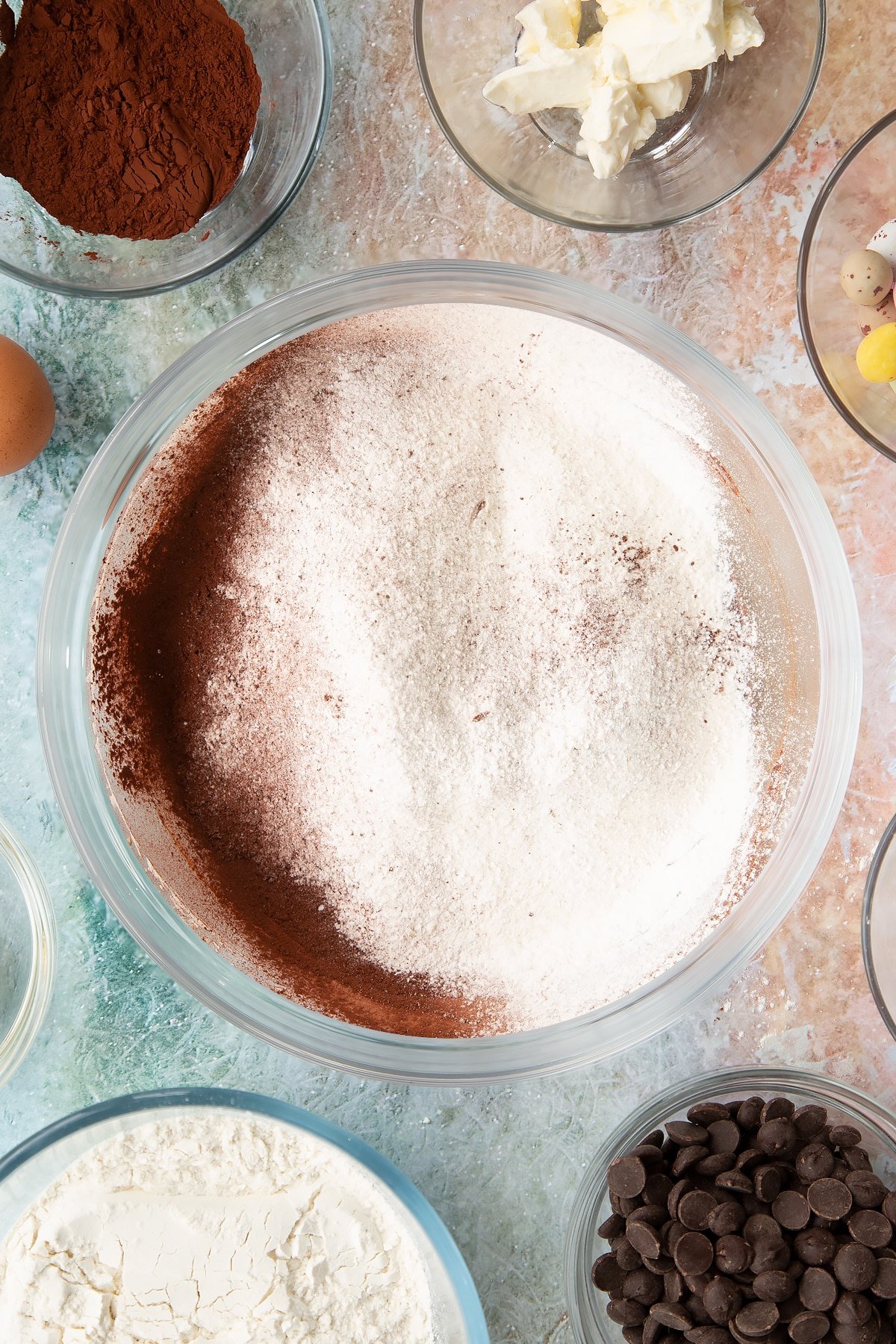
Mix to produce a chocolate dough.
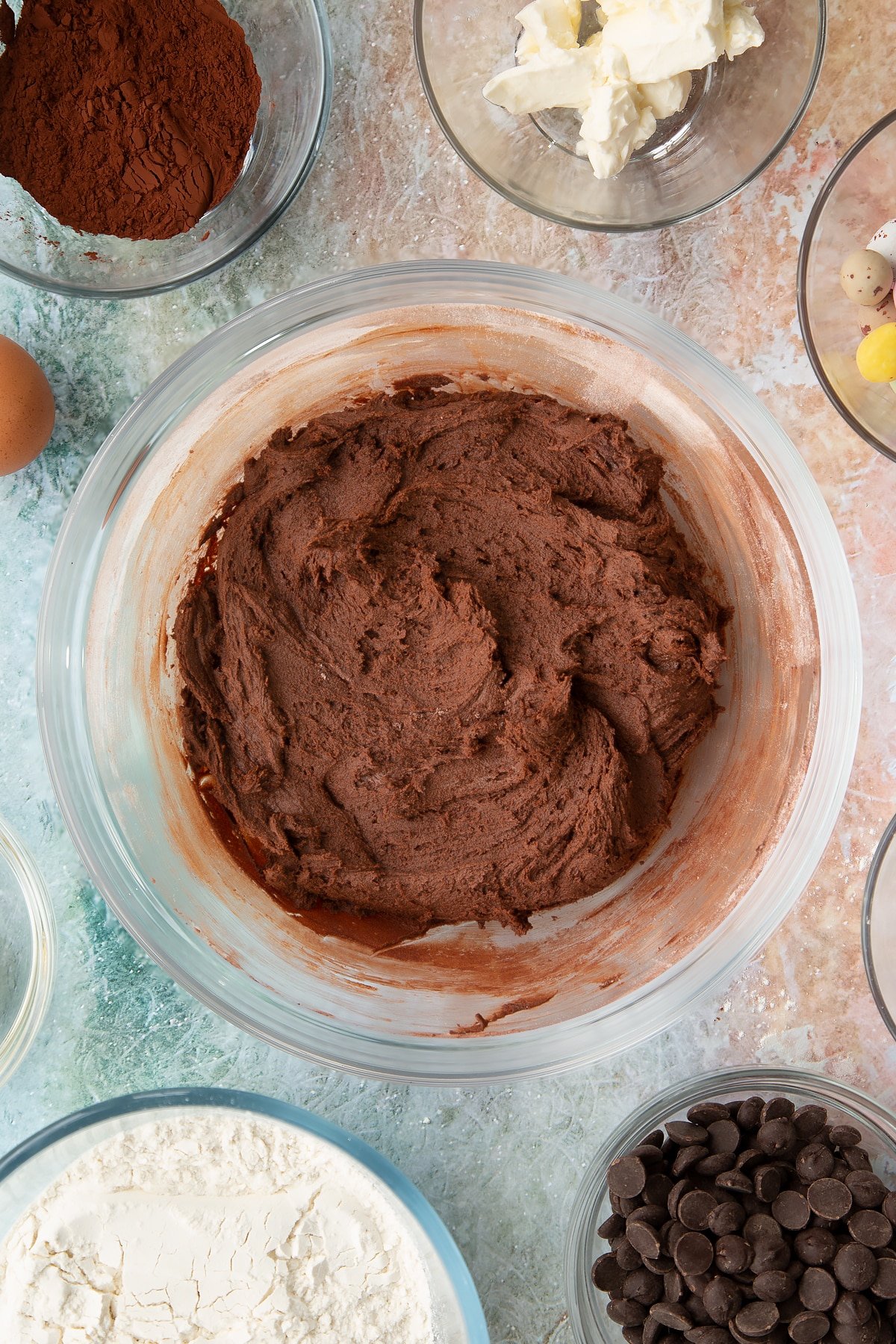
Add the white chocolate chunks.
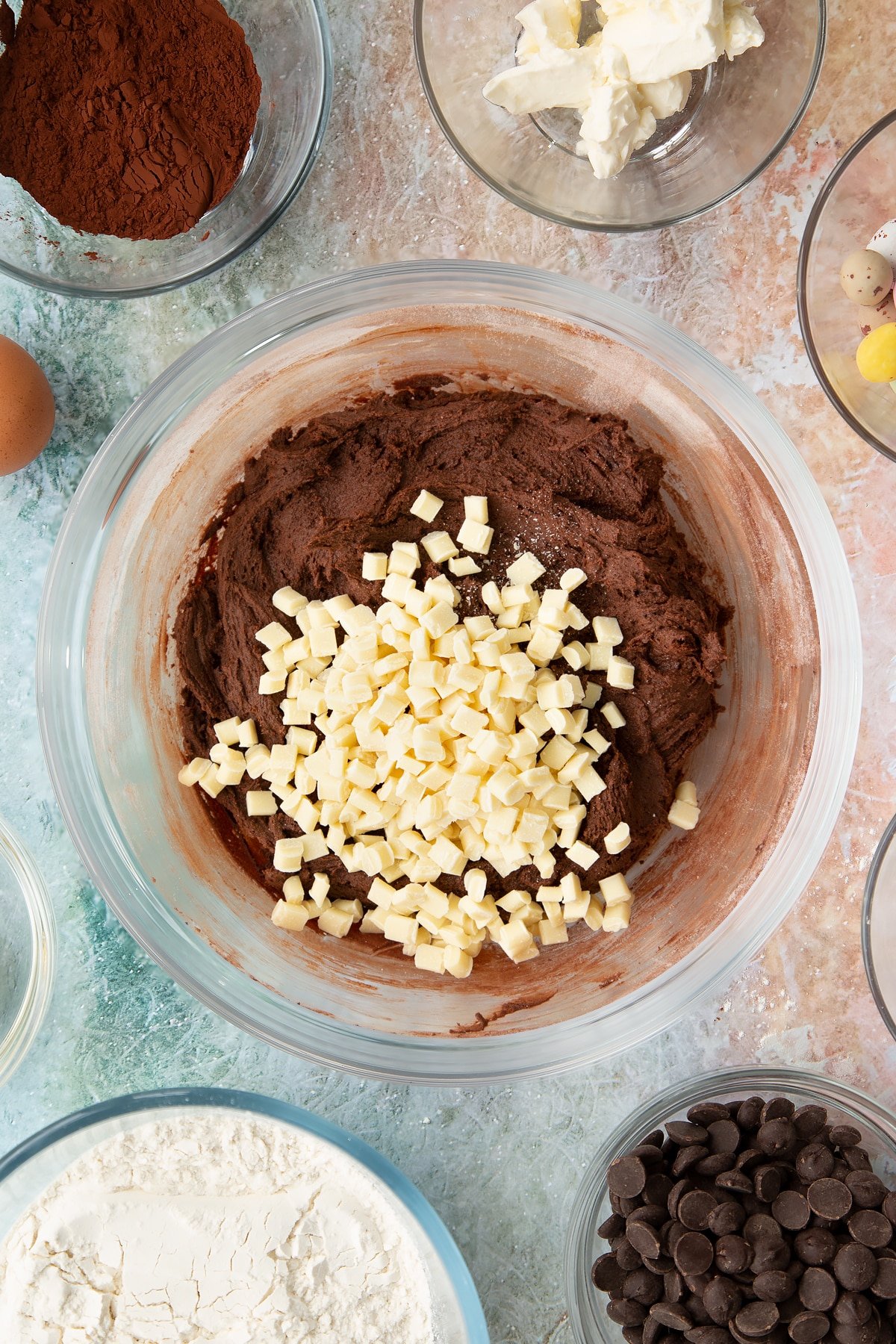
Mix!
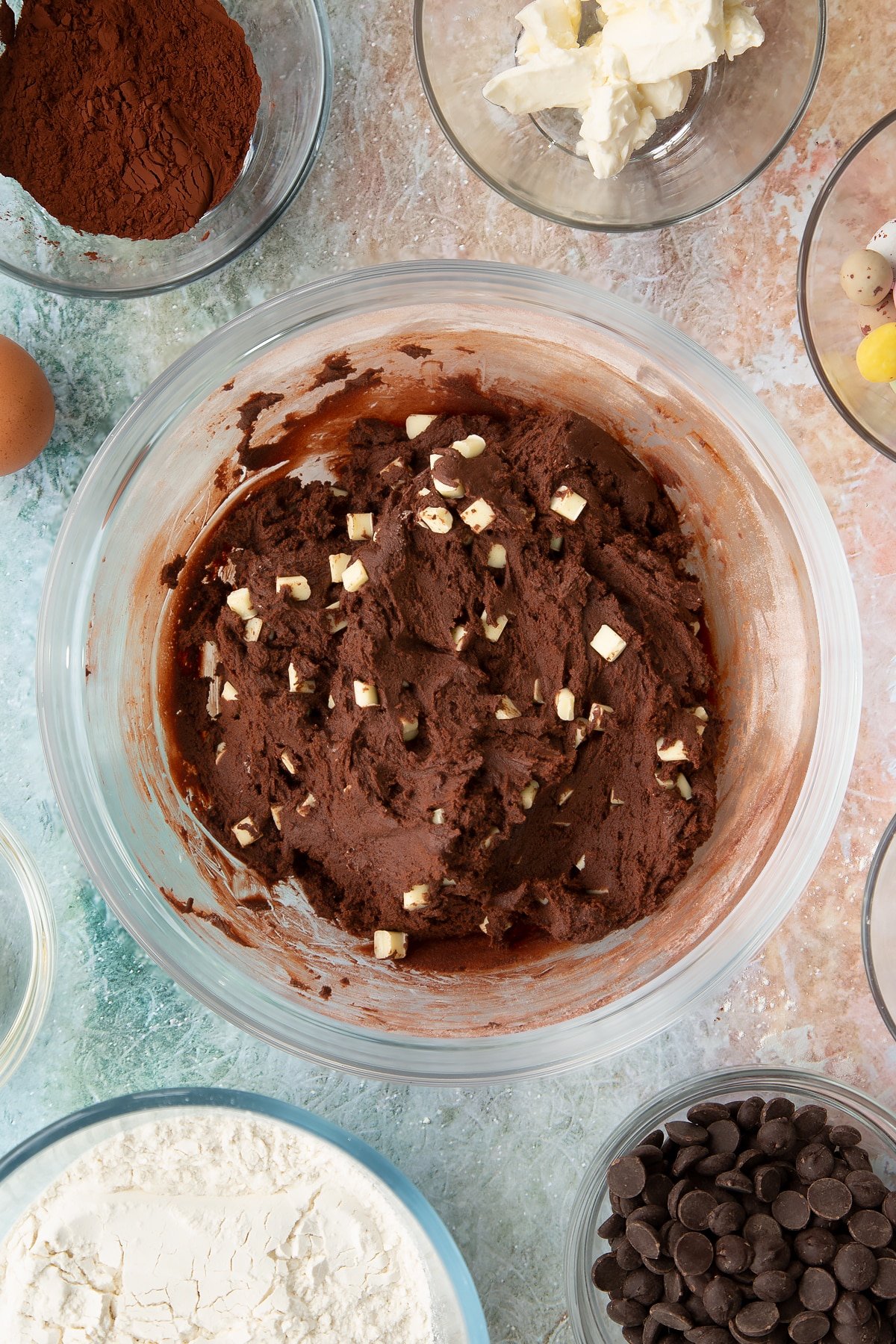
Add the chopped mini eggs.
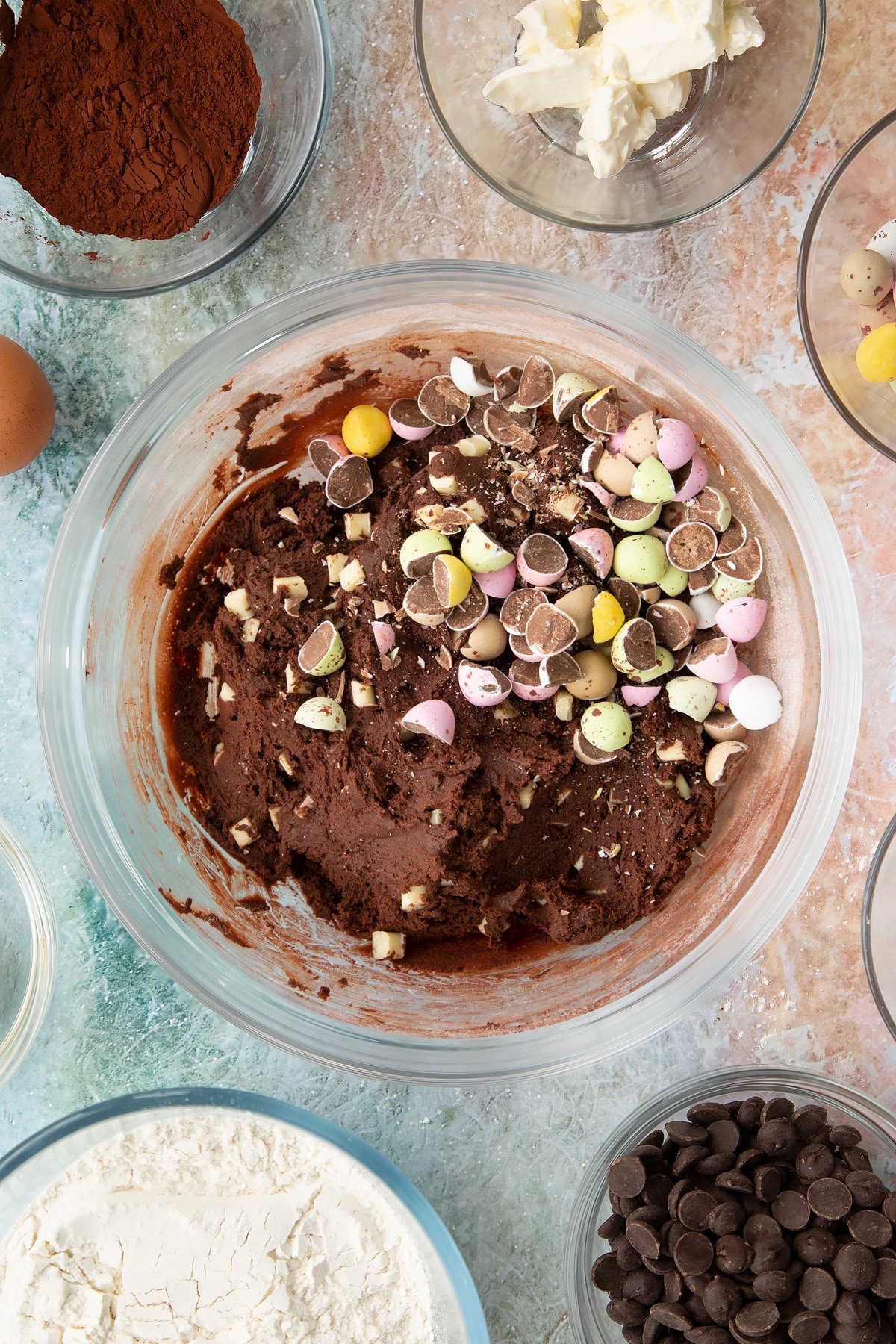
Mix to evenly distribute throughout the dough.
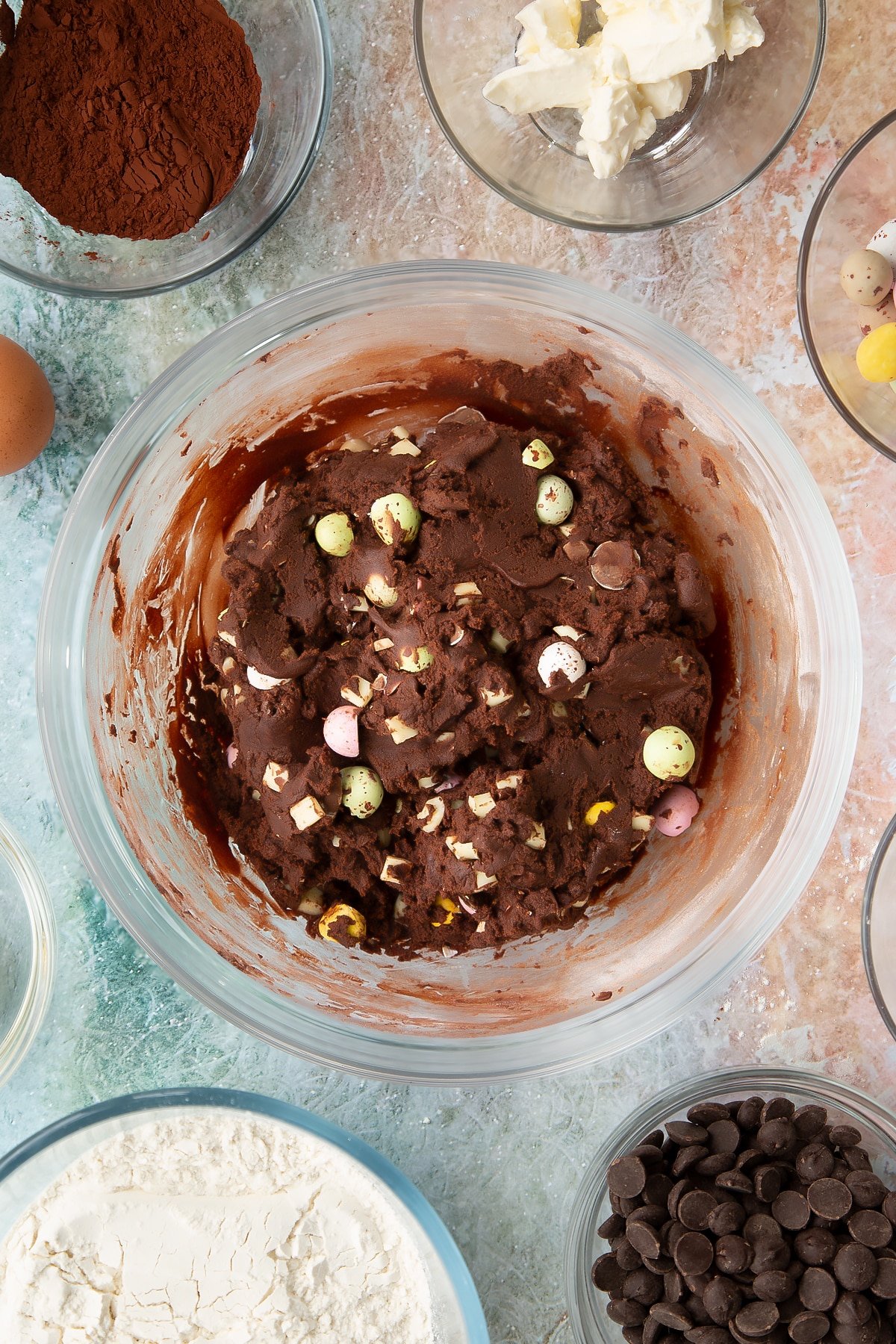
Divide the mixture into 16 pieces, rolling into balls with your hands. Place the balls on lined baking sheets, making sure you allow plenty of room for them to spread.
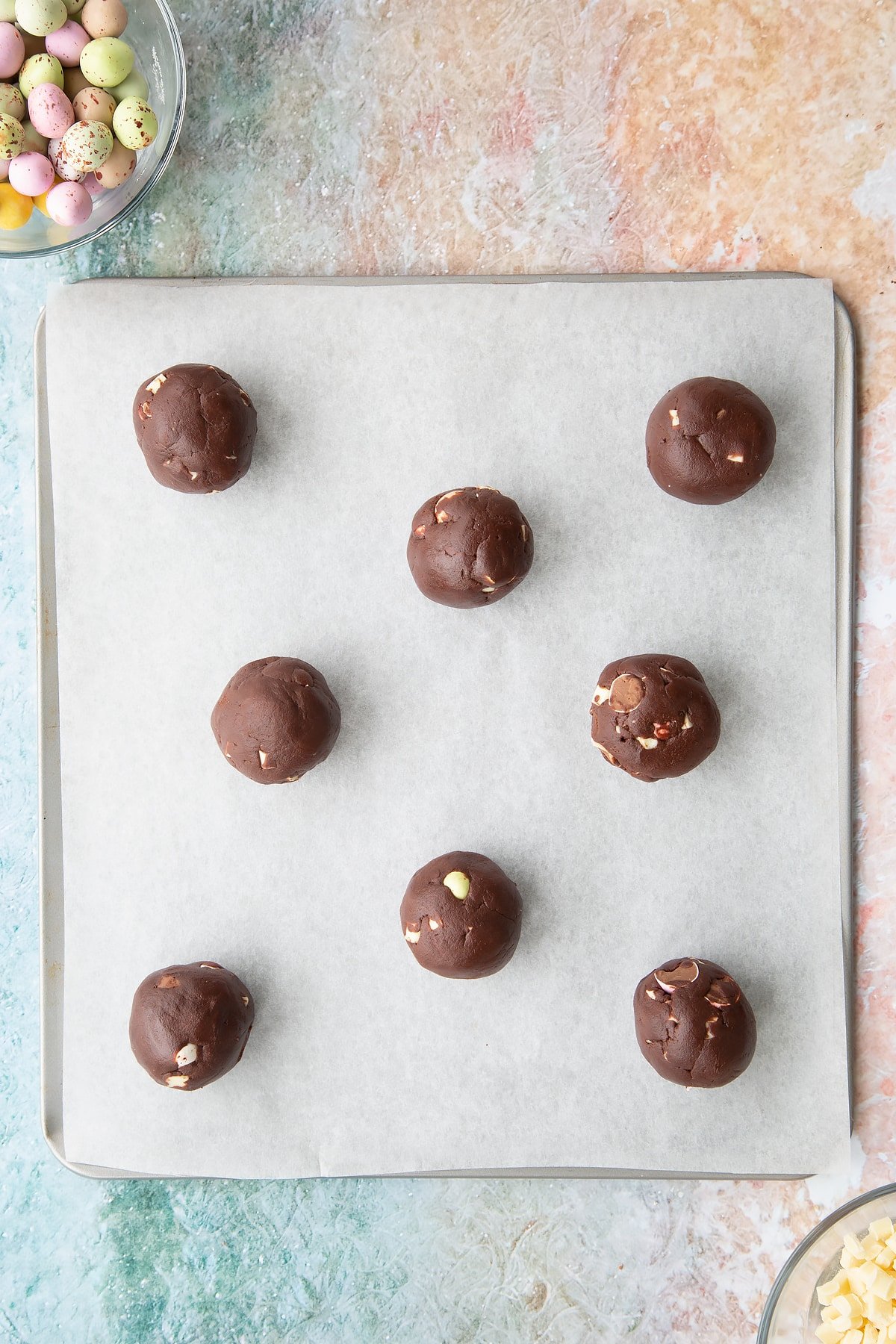
Bake in the oven for 12 minutes.
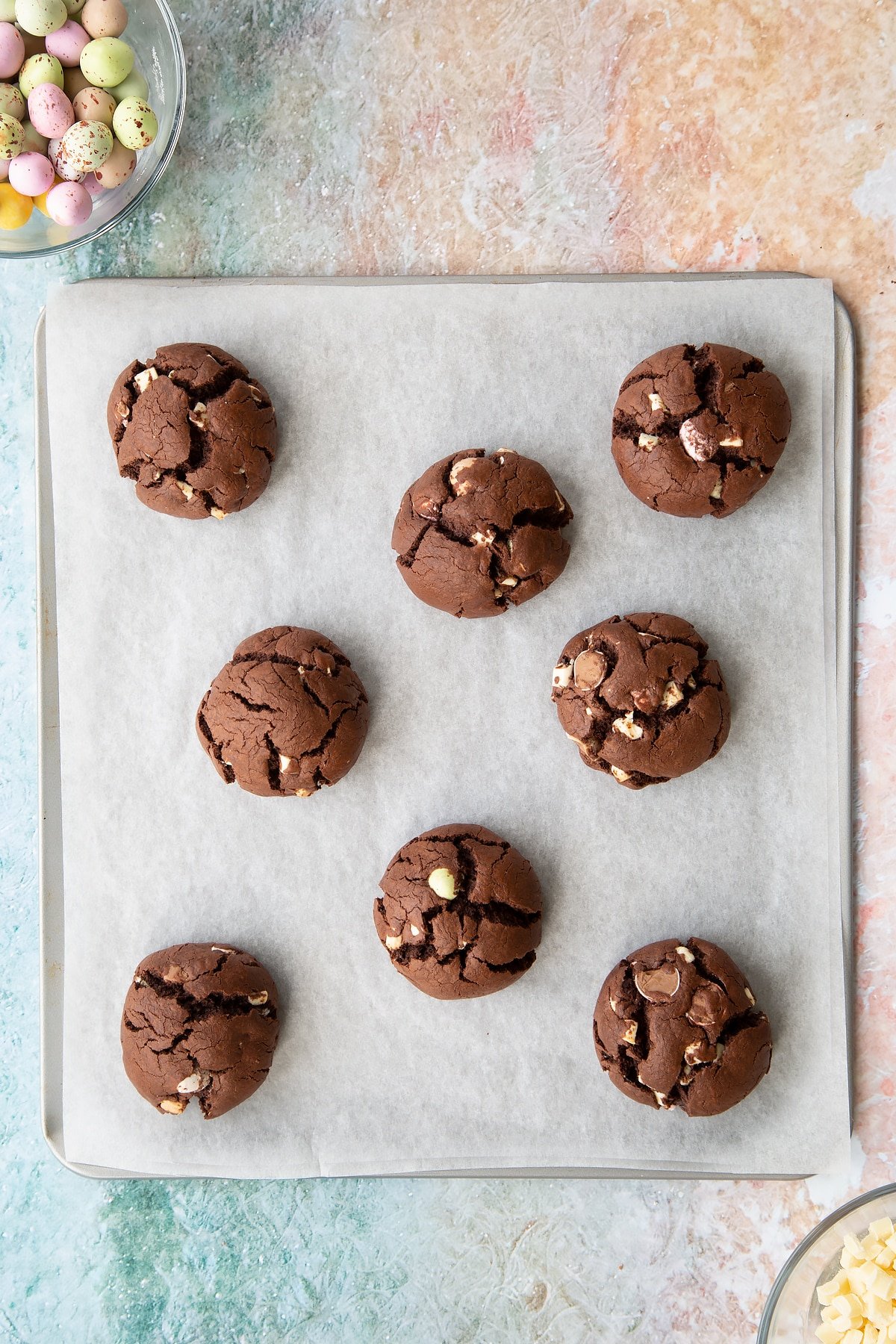
Once out of the oven and while still warm, gently press a melon baller or the back of a spoon into the centre of each cookie to make a little well.
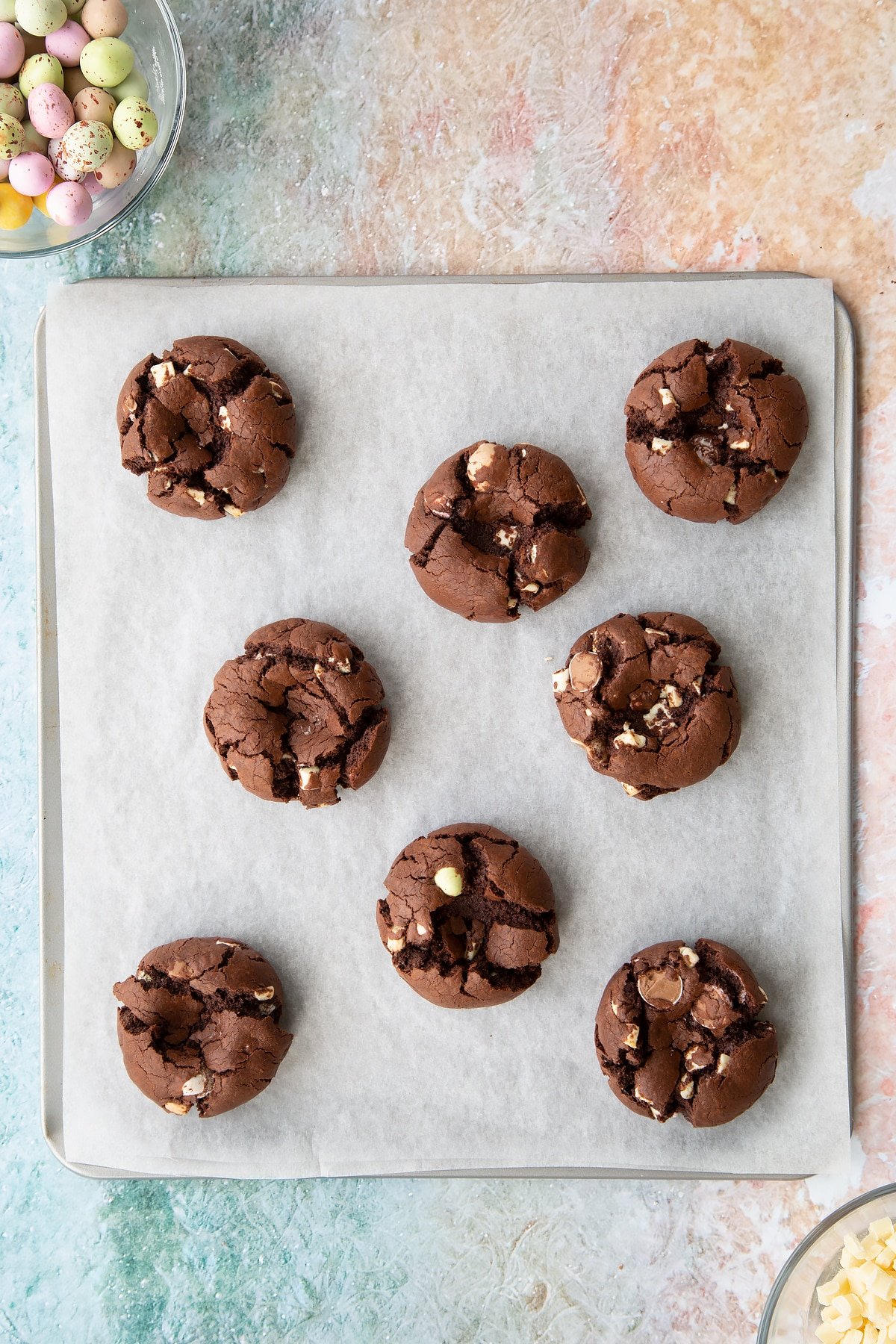
Make the topping
Melt white chocolate and allow to cool to room temp. Place in a bowl with the cream cheese.
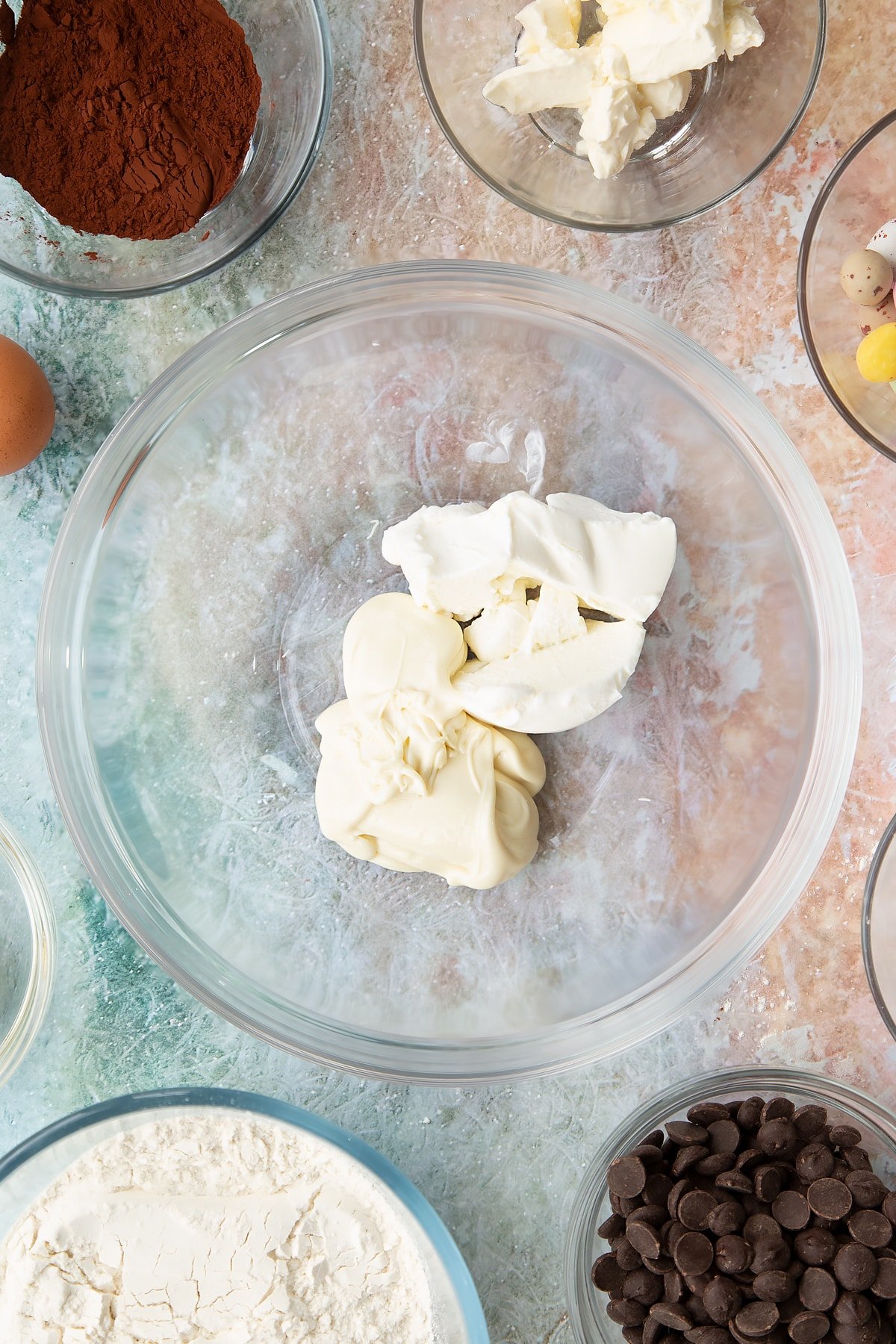
Whisk together to produce a smooth cheesecake mixture.
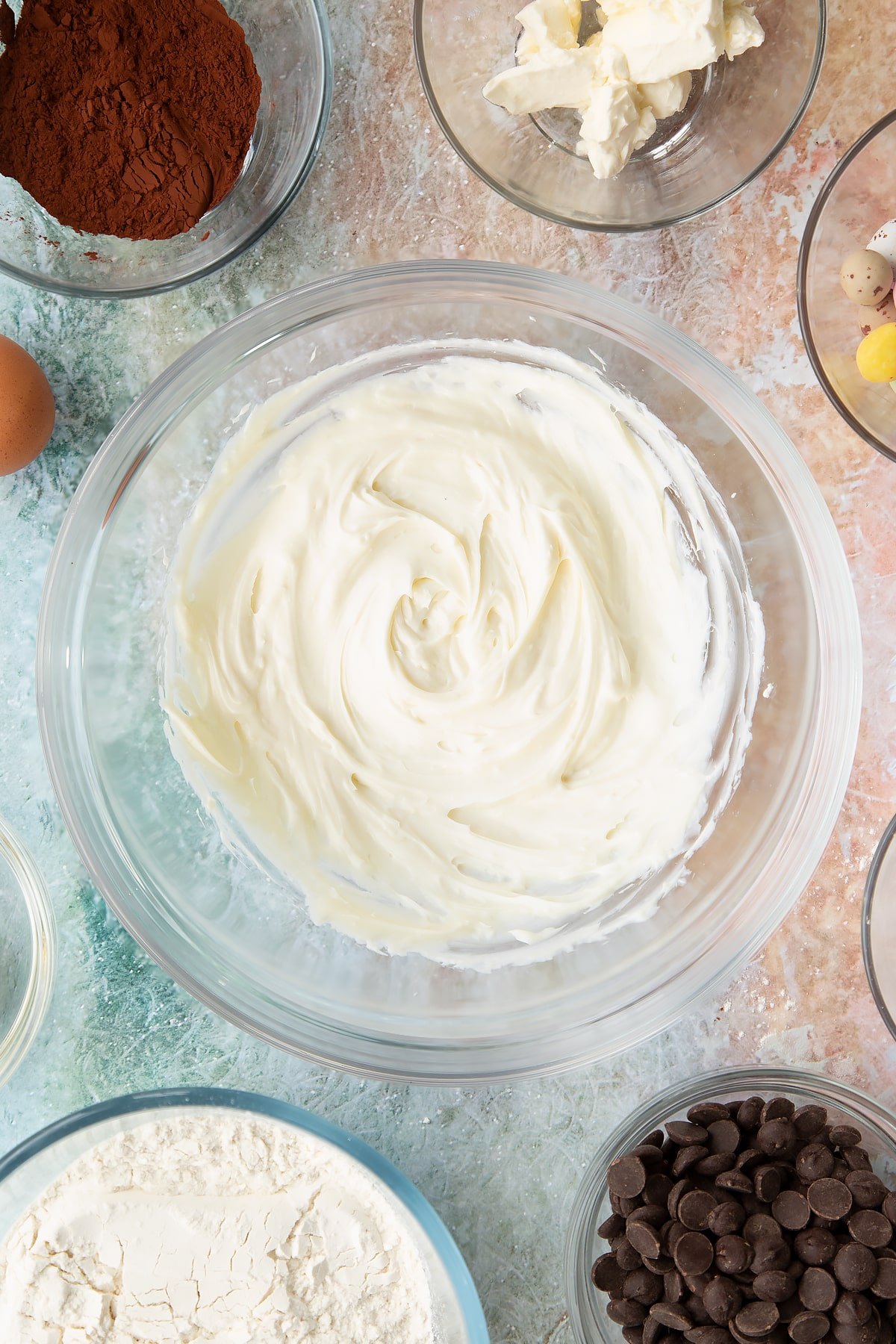
Place a teaspoon of the cheesecake mixture into the centre of each cookie.
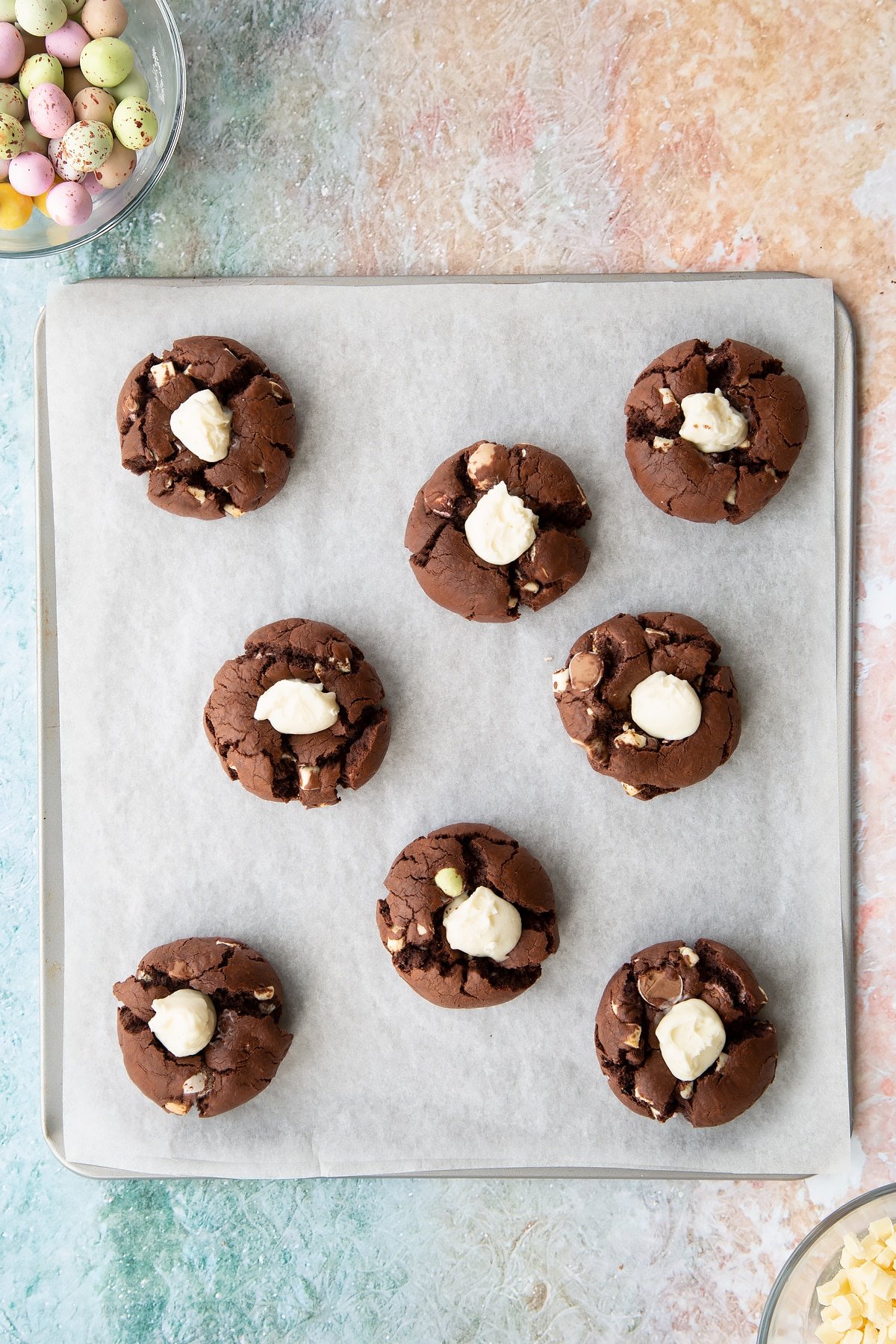
Place three mini eggs onto each cookie.
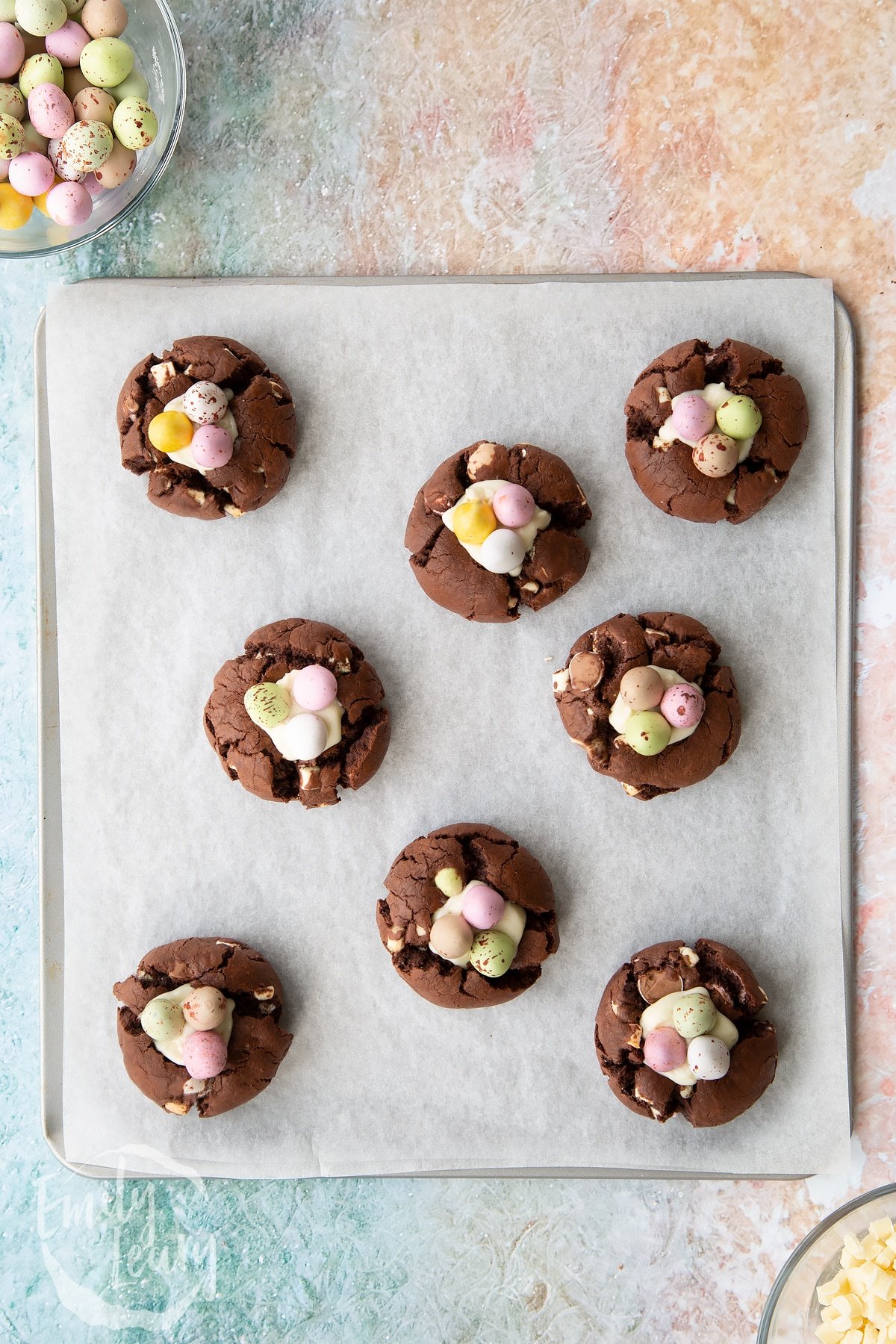
Transfer to a wire rack to finish cooling.
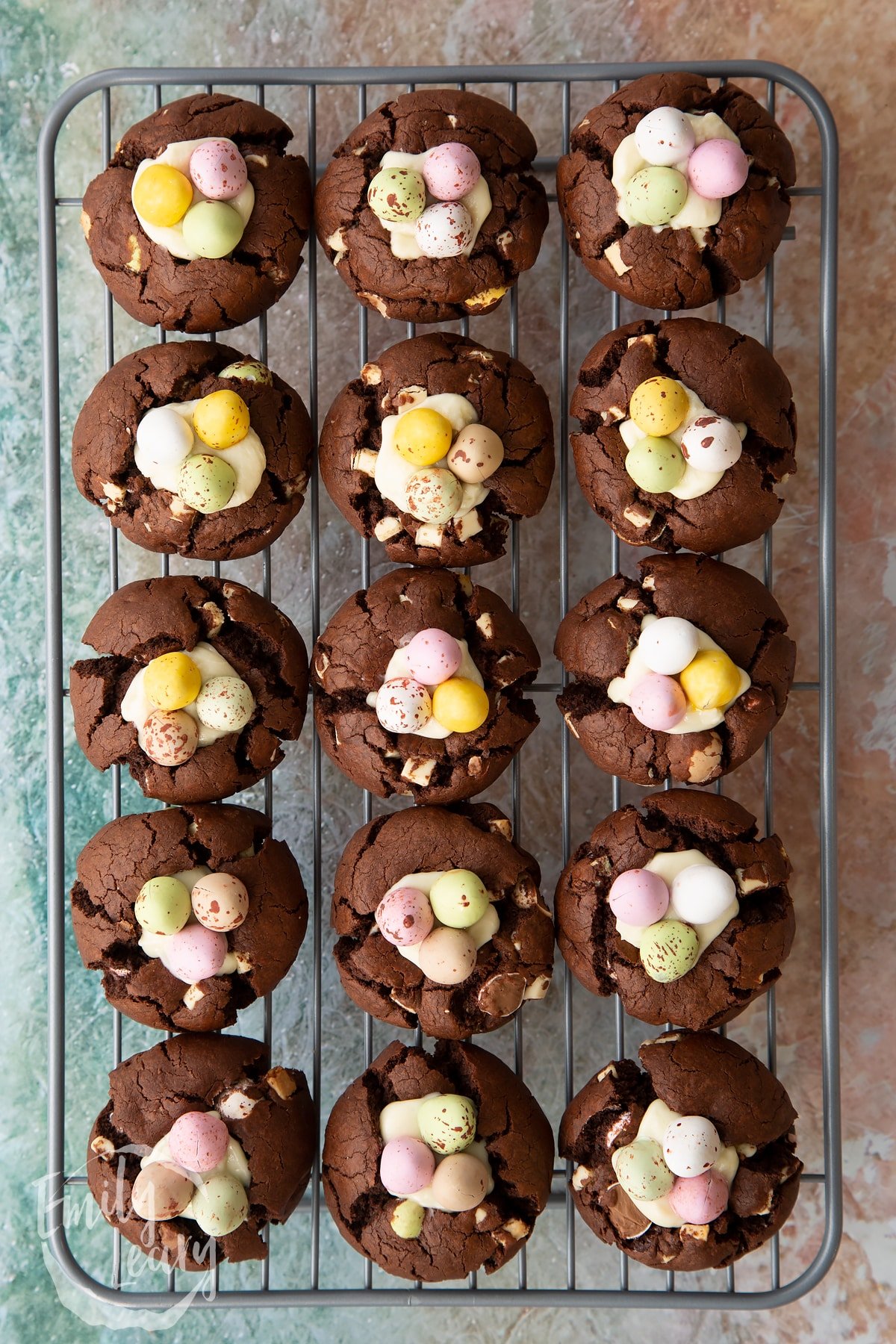
Serve these Easter cheesecake cookies as part of your Easter celebrations.
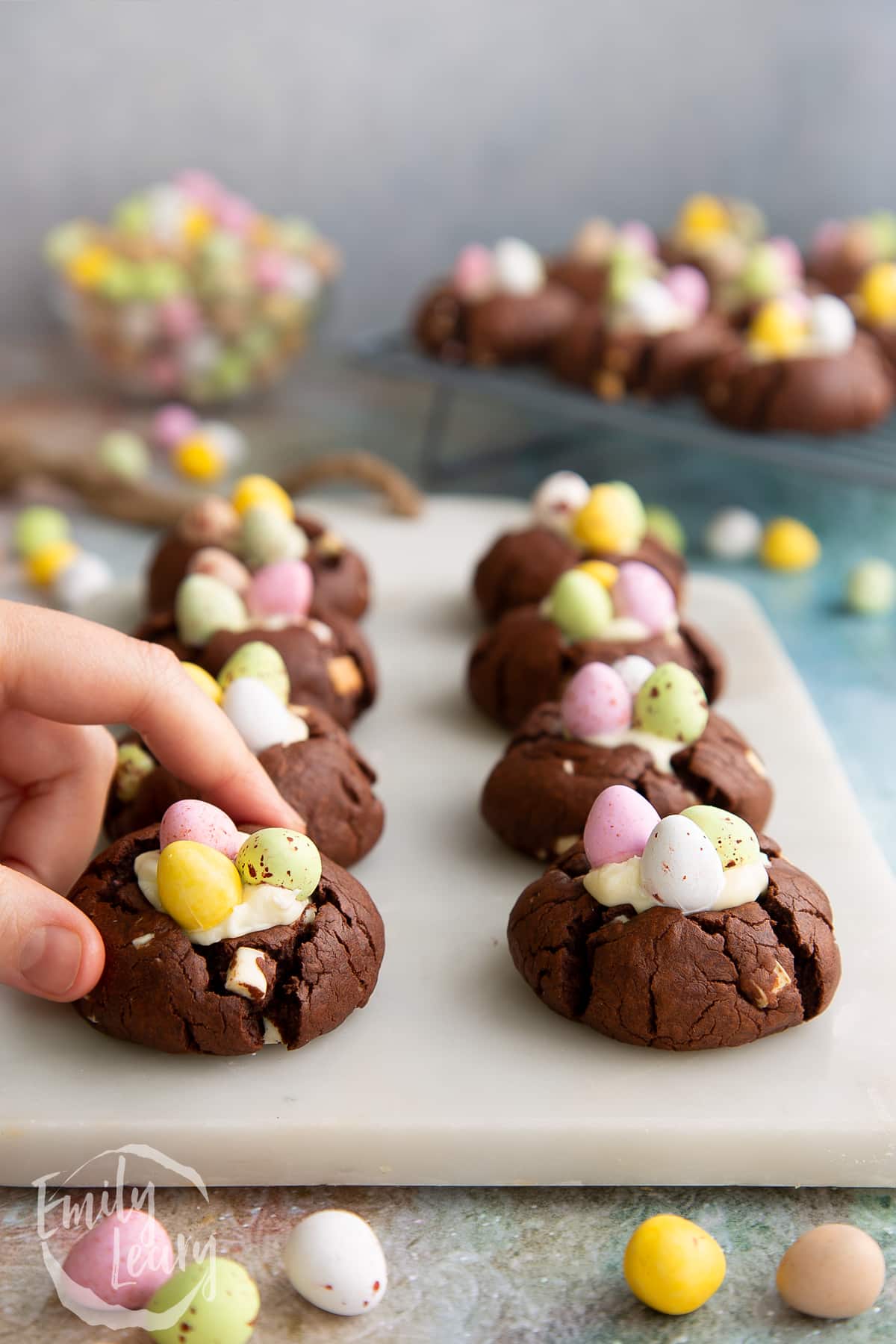
Enjoy the chocolatey goodness!
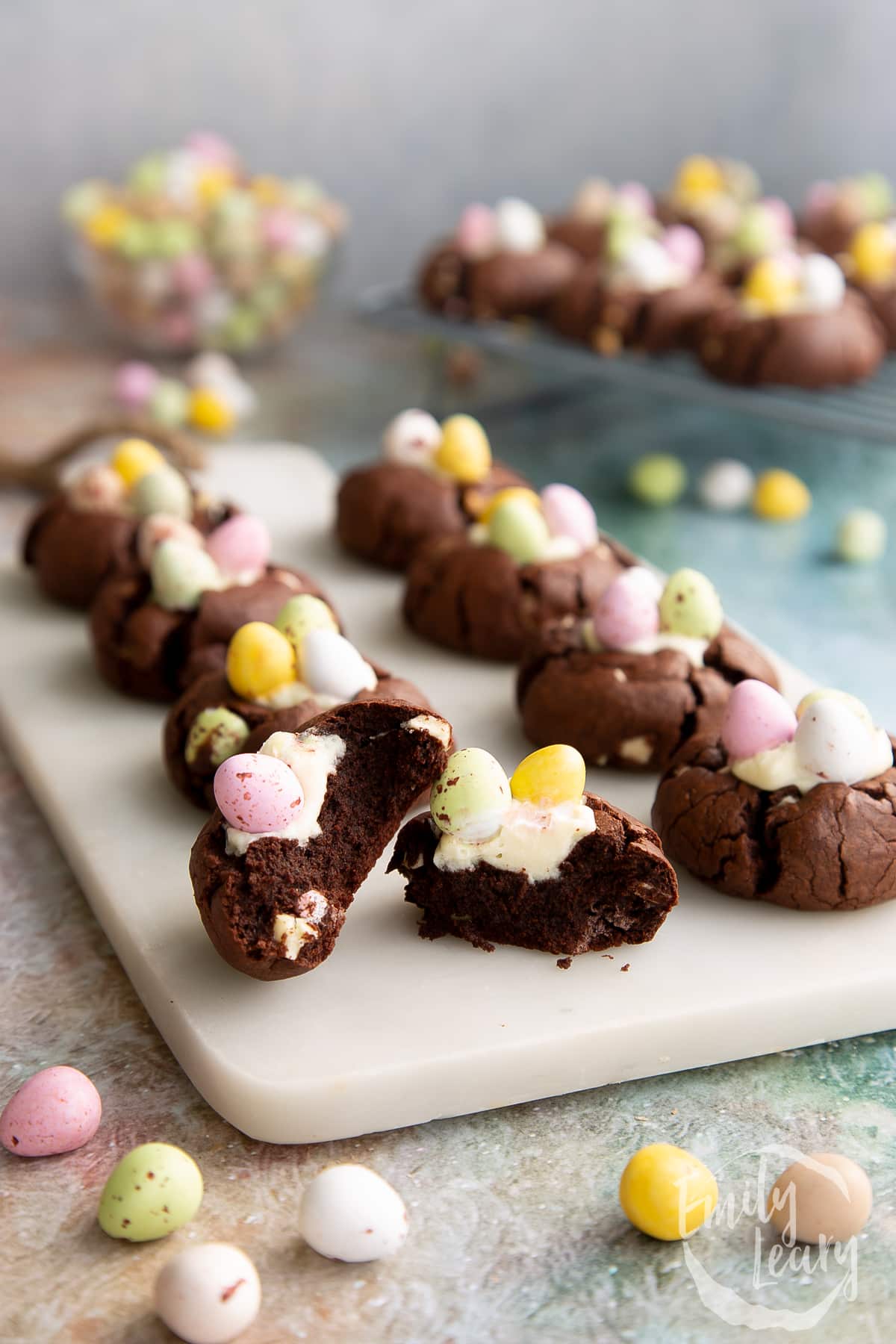
Pointers, tricks and troubleshooting tips for the perfect Easter cheesecake cookies
Are Easter cheesecake cookies easy to make?
These Easter cheesecake cookies are so easy to make considering how impressive they look that you’ll be pleasantly surprised!
I designed this recipe and the steps above to get the best results in a household kitchen, so hopefully you’ll have everything you need to get you to a delicious plate of Easter cheesecake cookies.
Each stage of the recipe has a corresponding photo, so you can see exactly what your recipe should look like at every stage. If you have any extra questions, hopefully the following sections can help you!
Will I need any special equipment to make Easter cheesecake cookies?
This recipe uses standard baking equipment, so even if you’re a regular baker you should have everything you need.
For example, you’ll need some measuring scales and spoons, baking trays and baking paper, a knife, a chopping board and a bowl - all of which you will probably already have.
The only everyday equipment you might not have is an electric whisk, but you can mix your dough and cheesecake topping by hand if needs be.
If you’re in doubt, there’s always a full list of suggested equipment on the recipe card below my recipes. I always include links to example products, so you can see exactly what I used to make each recipe.
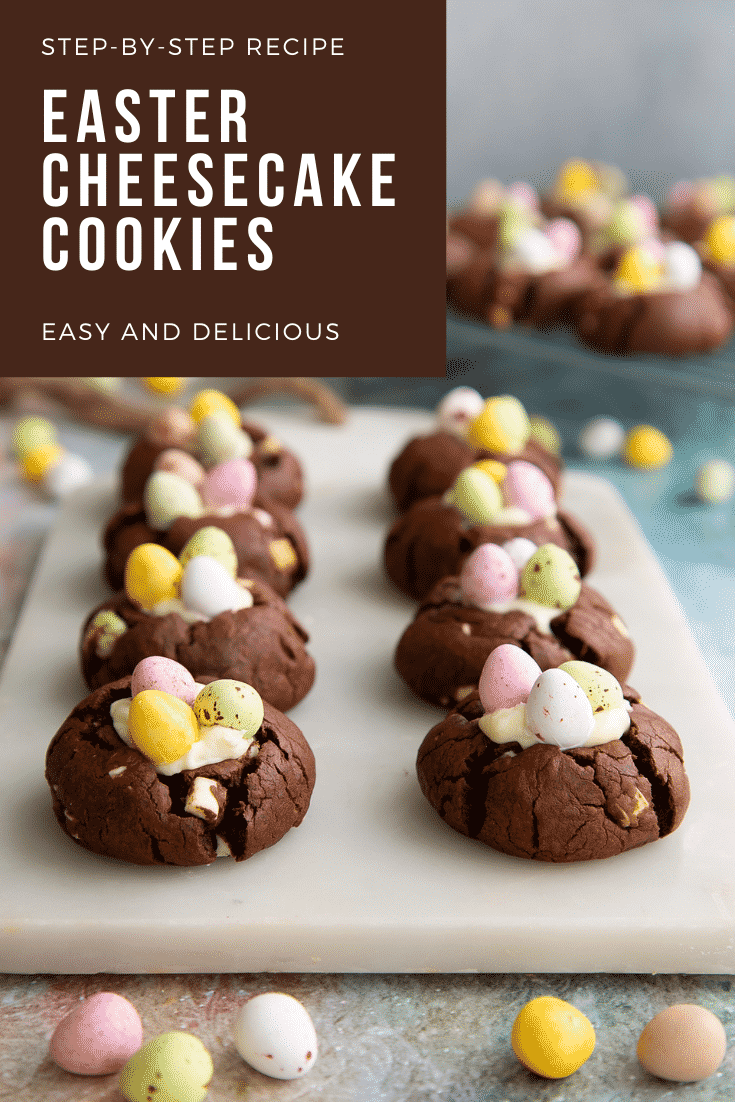
How can I tell if eggs have gone off?
To avoid your eggs spoiling, you should always follow the storage instructions on the egg packet. For example, in the UK, it's recommended that eggs are kept consistently below 20C, which means it's best to keep them in the fridge at home.
Egg safety standards can vary depending on where you live, so storage and use advice can differ too. So make sure you consult your local advice for the best way to keep your eggs as fresh and safe as possible.
It's always best to use fresh eggs, as they can behave differently in recipes as they get older and their quality declines, especially if they have been stored incorrectly.
If your egg has any cracks on the outside you should discard it, as it will have been exposed to air. If the inside of your egg looks, smells, feels or tastes odd in any way. So if your egg has any discolouration, odd appearance, or a strange or foul odour, it is most likely rotten.
If your egg has spoiled, you should immediately throw it away and thoroughly wash any pots and utensils that have come into contact with it.
Float test
If you aren't sure if your egg is fresh, you can place your egg in a cup or bowl of water to see if it sinks or floats.
To ensure you don't contaminate a recipe with a spoiled egg, it's always best to crack your eggs into a separate bowl or cup before adding them to a recipe.
Egg safety is crucial if you're cooking for someone in a vulnerable or at-risk group, such as older people, people living with health conditions, or a pregnant person.
A Mummy Too does not give medical advice. Please consult with your medical professional.
How can I tell if butter has gone off?
When butter spoils, it usually turns dark yellow, and sometimes it will even develop translucent patches. Spoiled butter can also develop a layer of condensation like sweat (ew, sorry), on it as water escapes.
These changes occur when bacteria cause the bonds between the fat, protein and liquid to unlink from each other. Lactic acid is released during this process, often producing a sour smell similar to spoiled milk.
Sometimes spoiled butter can look completely normal, so you should always taste it before including it in a recipe. If it tastes weird or feels fizzy, it isn't safe to use.
How can I tell if cream cheese has gone off?
When cream cheese is spoiled, it tends to dry out and develop cracks like a dead lake across the surface. The liquid and the fat separates as it spoils, so the liquid may separate and pool at the bottom of the pack.
Spoiled cream cheese will often develop mould, as it's a perfect environment for bacteria to grow.
If your cream cheese has any of these signs, you should immediately discard it and wash anything it came into contact with.
Are Easter cheesecake cookies suitable for vegetarians?
At the time of writing (March 2022), this recipe is completely vegetarian. However, make sure you check the labels of the ingredients you use, as some manufacturers can include animal-derived products.
Also, don't forget to check anything extra that you intend to serve with your recipe.
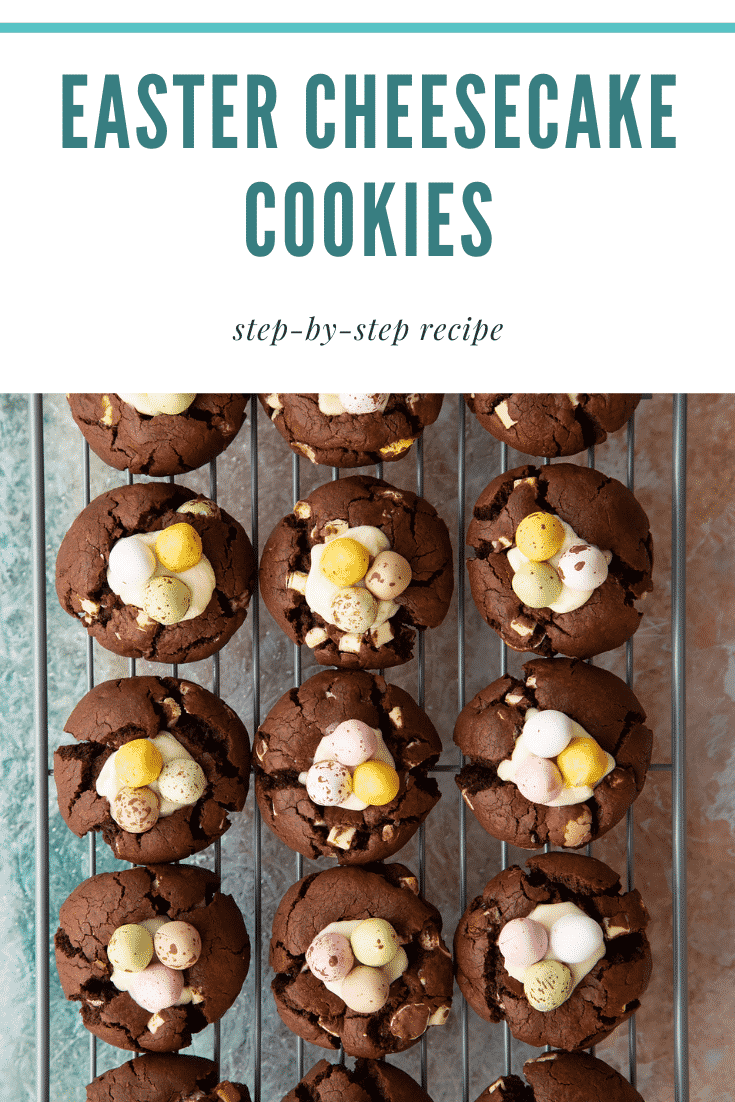
Are Easter cheesecake cookies suitable for vegans?
These Easter cheesecake cookies aren’t vegan as they contain dairy and eggs. I haven’t made a vegan version of this recipe, but you could give it a try with the vegan ingredients below:
Cream cheese:
Cream cheese is one of the easier cheeses to replicate as a vegan substitute. So, many supermarkets will sell their own brand of vegan cream cheese. You’ll usually find vegan cream cheese in the Vegan or Free From refrigerated aisles. Violife makes a vegan cream cheese which is widely available in Europe, though there are many other brands available.
Butter:
To replace the dairy butter, you can use a dairy-free baking block or spread with a fat with a content of around 80% as this will be similar to butter. Brands like Violife, Naturli and Flora make good quality vegan butter with the right fat content. I tend to use Flora, as they’re one of the few brands to make a salted and unsalted version of their vegan butter.
Egg:
To replace the egg, you'd need to use a store-bought vegan egg replacer, or you could use one of the following:
- 3 tablespoons of aquafaba. Aquafaba is the water you get in a tin of chickpeas. The proteins in the liquid mimic egg whites' behaviour, making an excellent egg replacer. But don't worry, it won't taste like hummus!
- 1 tablespoon of crushed chia seeds or flax seeds mixed with 2 tablespoons of water and left for 10 minutes in the fridge.
- 3 tablespoons of applesauce (though bear in mind this will make the cookies sweeter).
White chocolate / Dark chocolate:
For the melted white chocolate, it would be best to use vegan chocolate which is designed for melting, so you can be sure it will behave in a similar way to dairy chocolate. These oat milk-white vegan melts might be a good place to start. Though as I said, I haven’t tried making a vegan version of this recipe, so I can’t be sure how it will turn out.
For dark chocolate, you could use vegan dark chocolate. In the UK, many supermarkets make their own brand of dark chocolate. This Marks and Spencer’s ‘Made Without’ version would probably work very well.
Mini Eggs:
In the UK, there’s a brand called Doisy and Dam that produces really good quality vegan Mini Eggs. They're usually available in Holland and Barrett, or on Amazon. However, some supermarkets (Sainsbury's, Asda) sell them in the run-up to Easter too!
Always make sure that you double-check all of your ingredients labels to ensure that they’re vegan friendly. Also, don't forget to check anything extra that you intend to serve with your recipe.
Are Easter cheesecake cookies gluten-free?
These Easter cheesecake cookies aren’t gluten-free, as they contain wheat flour. However, as of March 2022, and depending on the brand you use, the only ingredient in this recipe containing gluten is flour.
So you could swap the plain wheat flour for plain gluten-free flour, like this plain gluten-free flour from Doves Farm, and the recipe will be gluten-free! Woo!
Double-check all of your ingredients labels to make sure that they are gluten-free. Don't forget to check anything extra that you intend to serve with your Easter cheesecake cookies.
Are Easter cheesecake cookies keto-friendly?
Unfortunately, this recipe isn't keto-friendly as it is mainly carbohydrate and sugar-based, sorry!
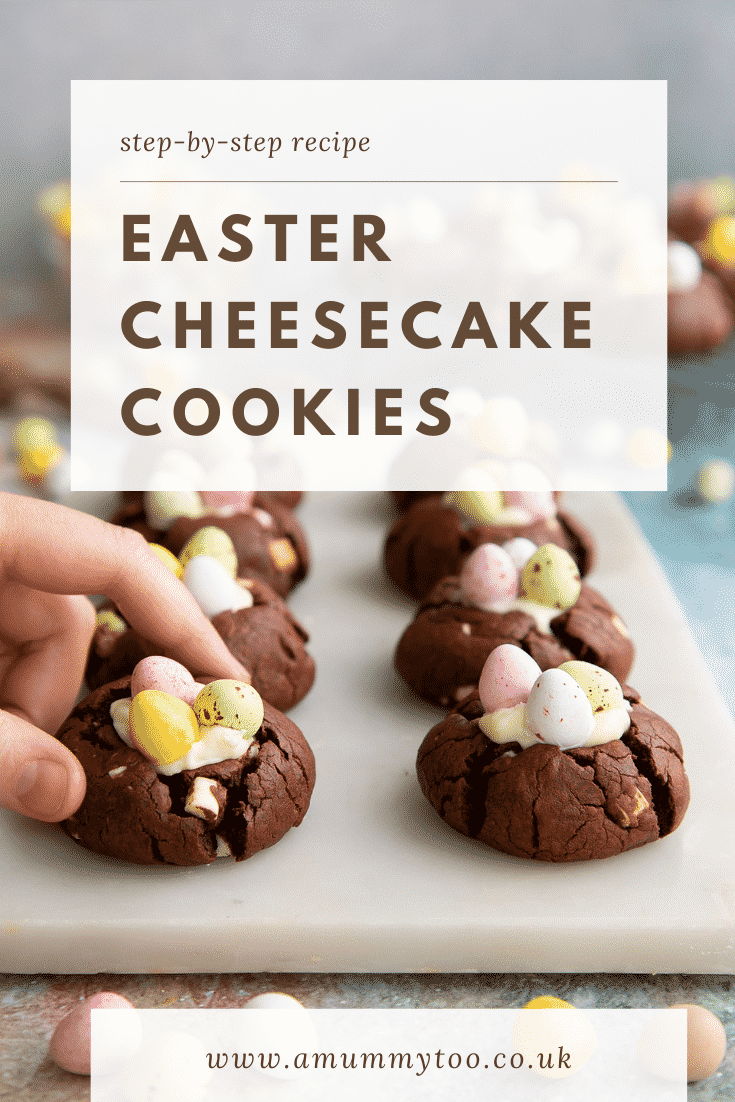
Are Easter cheesecake cookies healthy?
These Easter cheesecake cookies contain a lot of sugar and fat, so they’re best enjoyed as an Easter treat or on special occasions.
There’s nothing wrong with enjoying a treat on occasion, as long as you balance it with an otherwise healthy and varied diet.
Are Easter cheesecake cookies safe to eat while pregnant?
There’s nothing in this recipe that would be of concern to a pregnant person.
In the UK, pregnant people are told to avoid soft cheeses by the NHS. This is because soft, unpasteurised cheese can contain listeria, a dangerous bacteria.
However, cream cheese sold in supermarkets is pasteurised (unless the label states). So there should be no risks associated with it in this recipe.
Make sure that all of your ingredients are in good condition and that this meal is prepared safely and hygienically.
A Mummy Too does not offer medical advice. Please seek help from a medical professional if you need further information or have any concerns.
What goes well with Easter cheesecake cookies?
These Easter cheesecake cookies are super moist, so they’re great on their own. Or if you’re a creature of habit, you can still dunk them into a cup of tea or coffee.
Can I add extra chocolate to this recipe?
These Easter cheesecake cookies are probably around 80% chocolate. But if you can think of a way to fit more in, go ahead!
The only option I could think of is that you could drizzle melted milk chocolate over the top of your cheesecake topping for colour contrast.
How should I store Easter cheesecake cookies?
Once you top the cookies with the cheesecake mix, you will need to refrigerate your Easter cheesecake cookies. This is because the cream cheese will spoil if kept at room temperature. However, you can store your undecorated cheesecake cookies in an airtight container in the cupboard or pantry until you decorate them.
How long will Easter cheesecake cookies keep?
Your Easter cheesecake cookies should keep for 3-5 days as long as you store them in the fridge in an airtight container. They will become softer as time goes on, so its best to enjoy them as close to the day you make them as possible.
Can I leave Easter cheesecake cookies out on the counter?
No, if you leave your Easter cheesecake cookies out on the counter, the cheesecake topping will spoil within a few hours. So it's best to keep them in the fridge when you aren’t serving them.
Can I make Easter cheesecake cookies ahead?
You can make the cheesecake cookies a couple of days ahead if you like, but they won’t be as crisp or fresh tasting. So it's always best to make them on the day you wish to serve them.
Can I keep Easter cheesecake cookies in the refrigerator?
Yes, the best place to keep your cookies is in an airtight container in the refrigerator. It's best to layer them between sheets or pieces of parchment so as to avoid the topping from getting damaged or looking scruffy.
Can I freeze Easter cheesecake cookies?
While you can technically freeze your Easter cheesecake cookies, I wouldn’t advise it. The cheesecake filling will most likely split as it defrosts, causing the cookies to absorb the water and become soggy.
Also, because of the cheesecake topping you won’t be able to crisp the cookies up in the oven. Plus, they will look quite scruffy once you defrost the cookies.
What is the best way to defrost Easter cheesecake cookies?
As I said, I wouldn't recommend freezing your cookies. However, if you do decide to freeze them, you can place the cookies in the fridge for a few hours to defrost.
Can I make these Easter cheesecake cookies in a different quantity?
If you want to make more or less of this recipe then go right ahead. Luckily, the cookies cook individually, so you won’t need to adjust the cooking time or temperature.
You can increase or decrease the recipe manually by working out the individual portion amounts and multiplying the recipe by the amount you wish to make, or you could use an online recipe calculator.
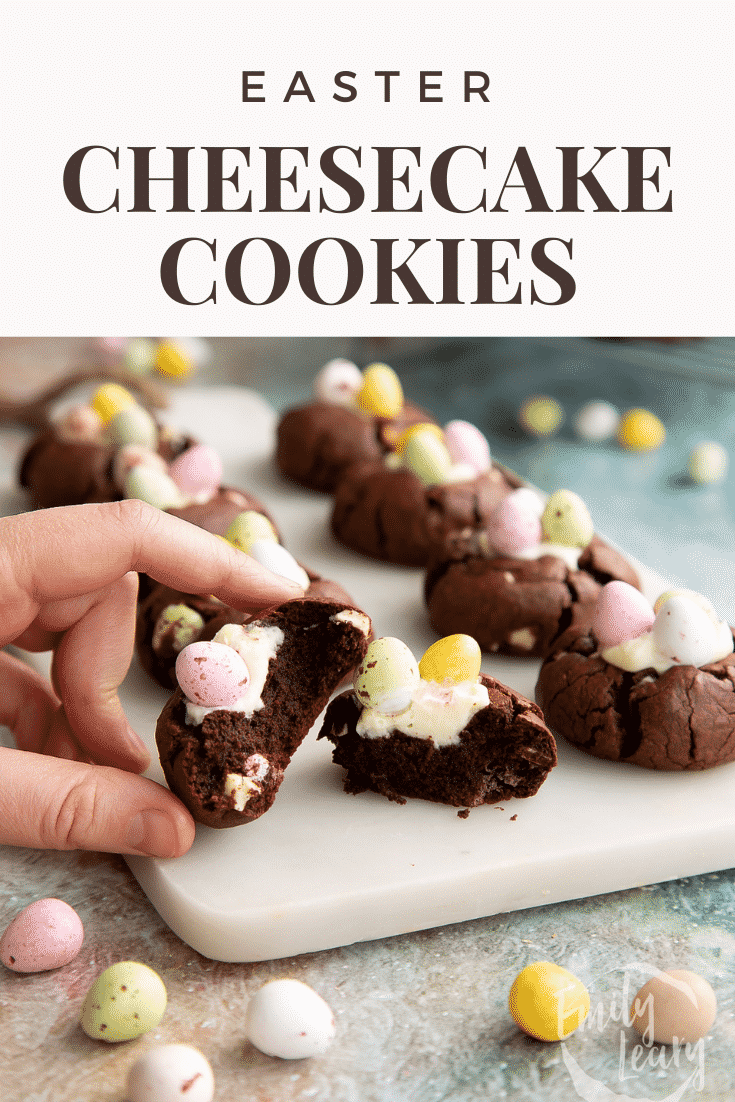
Can I make Easter cheesecake cookies in a stand mixer such as a KitchenAid or Kenwood Mixer?
Yes, you could use a stand mixer with a paddle attachment to mix each stage of your Easter cheesecake cookie ingredients.
It's probably best to use the balloon whisk attachment. Go slow at first when creaming the wet ingredients together, so they don't spray everywhere.
However, once you add the flour, cocoa and raising agents, make sure not to over-mix the dough as it may become tough. Your dough only needs to be brought together, not kneaded like bread dough.
When you overmix cookie dough the gluten in the wheat flour activates, causing it to behave more like unleavened bread dough.
Similarly, when you add the chocolate Mini Eggs, you should only briefly pulse the dough to distribute the Mini Eggs. You don't want to break the Mini Egg pieces down too much.
Remember to scrape the sides down between each ingredient, so you don't end up with half of the ingredients left caked on the side of the bowl.
Can I make Easter cheesecake cookies with a food processor?
A food processor would be too powerful for this recipe and it would break down the ingredients too much.
How can I make sure my Easter cheesecake cookies are perfectly cooked?
To make sure your Easter cheesecake cookies turn out perfectly, there are a few points to watch:
- Ratios/measurements: Make sure you add the correct amount of ingredients. If you change the size of the recipe, make sure you ensure the ingredients are in the same ratio as the original recipe, otherwise your cookies may be too dry or too wet, causing them to undercook or burn. This is why I always weigh and measure out my ingredients before I begin, so I know exactly what to add.
- Order: Make sure you add your ingredients in the right order. If you add your raising agents too soon, the air they produce will be knocked out of the mix, resulting in flat, dense cookies.
- Timing: The cookies should only take 12 minutes to cook. So make sure you don’t overcook them, or they may turn out dry or even burnt. I find it’s always good to set a timer 5-10 minutes before the end of cooking time so you can check whether the cookies are at risk of burning.
- Temperature: You'll need to make sure that you preheat your oven to the right temperature. If you add your cookies to an oven that is too cool they won't rise or cook properly. Or if the oven is too hot, they'll quickly dry out and burn. If you find your recipes often burn in your oven, I would recommend buying an oven thermometer to check whether your oven is running at the correct temperature.
- Mixing: It’s important not to overmix your cookie dough and your cheesecake topping. Overmixing the cookie dough will result in dense, bread-like cookies as it will knock the air out of the dough and activate the gluten. And if you overmix the cheesecake filling, you’re at risk of causing the cream cheese to split.
Why did my cookies spread too much?
You’ll only need to press the cookies down to around half the height of the dough balls. If you press them more, you'll get thinner cookies, which will spread and probably bake more quickly.
If your cookies are very spread out, it may be because the oven was too cool before the cookie dough went in. This would cause the dough to melt and spread before it had a chance to cook and set into a cookie shape.
Another potential cause may be that the cookie dough was too wet. This can happen if you add too much liquid or fat, or if you forget to add one of the dry ingredients. This is why I always recommend measuring everything out before you start so that you're less likely to run into any problems with the ingredients.
Why did my Easter cheesecake cookies turn out dry?
If your cookies turned out dry, it may be because you forgot to add one of the wet ingredients. These cookies get a lovely moist texture from the addition of cream cheese. The chocolate chips and broken Mini Eggs should also help add moisture.
If you’re sure you added all of the ingredients to your recipe, then you may have overcooked your cookies. This can happen if the oven temperature is too high or if you leave them for too long.
If you’re a regular baker, it’s a good idea to invest in an oven thermometer to ensure your oven is running at the correct temperature. Many domestic ovens have incorrect temperature dials, so it's not a major issue.
When you set a timer, try and set it for 5-10 minutes before the cooking time is over. This gives you time to save any cookies at risk of burning.
Why did my Easter cheesecake cookies turn out wet?
If your Easter cheesecake cookies are very wet or dense, then they're either undercooked or you added too much of the wet ingredients.
If you’re sure you added the correct amount of ingredients, then give the cookies an extra 5 minutes in the oven and see if it helps. The cookies may still be a little soft when they’re cooked, and they firm up as they cool. So it may just be that they’re still soft from the oven.
If you think you added too much of the cream cheese or other wet ingredients, then you’ll need to start again. Next time, try weighing out the ingredients and putting them into individual bowls out in front of your prep area. This will help you see what you have to add and help avoid any mix-ups with measurements.
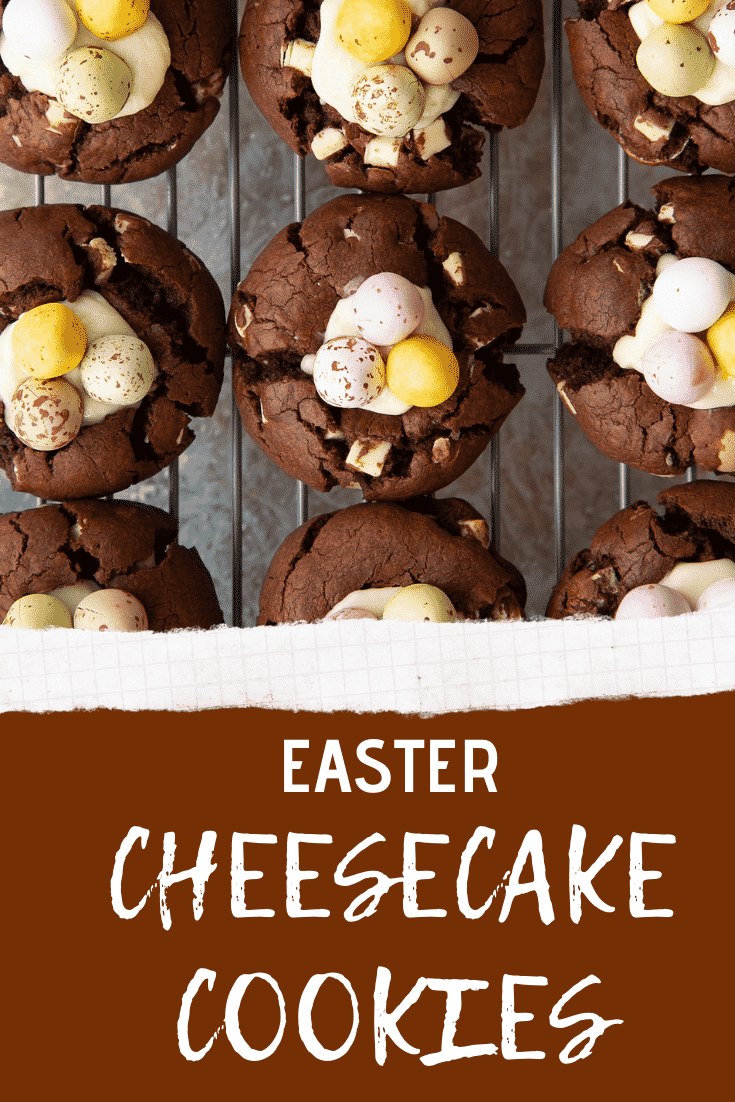
Why did my cheesecake topping split or turn very loose?
The cheesecake topping mixture is most likely to split if you add the melted white chocolate while it's still hot or if you overmix the cream cheese.
If your mixture has split, you can usually save it by whisking it over a bowl of ice, as it brings the temperature down and strengthens the cream cheese.
Next time, melt the chocolate at least 10-15 minutes before you start making the cheesecake filling. This will give it enough time to cool.
How can I add/change the flavours in these Easter cheesecake cookies?
These Easter cheesecake cookies are a super flavourful Easter treat with a chocolatey base and super creamy topping, but if you want to add your own twist to the recipe then go ahead!
You could start by flavour into the cookie dough. A flavour extract like coffee flavouring or some orange zest could work well to complement the creamy cheesecake topping. Or you could add some traditional baking spices like nutmeg or cinnamon.
If you want to make this recipe without Mini Eggs, or you just can't find any, feel free to use something like M&M’s. Though bear in mind M&M’s or other candy-coated chocolates can contain allergens which this recipe hasn’t accounted for.
Print this Easter cheesecake cookies recipe
Easter Cheesecake Cookies Recipe
Ingredients
For the cookie dough
- 75 g (⅓ cup) full fat cream cheese
- 50 g (½ stick) salted butter softened
- 150 g (⅓ + ½ cup) white caster sugar (superfine sugar)
- 160 g (5.5 oz) dark chocolate (bittersweet) melted
- 1 medium free range eggs
- 225 g (1½ cups + 1 tbsp) plain white flour (all purpose flour)
- ½ tsp bicarbonate of soda (baking soda)
- ½ tsp baking powder
- Pinch salt
- 30 g (¼ cup) cocoa powder (dutch processed)
- 100 g (3.5 oz) Mini Cadbury Creme Eggs
For the topping
- 100 g (⅓ cup + 2 tbsp) full fat cream cheese
- 100 g (3.5 oz) white chocolate melted
- 120 g (4 oz) Mini Cadbury Creme Eggs
Equipment
- Melon baller (or teaspoon)
Instructions
Make the dough
- Preheat the oven to 180C (160C fan / 370F) and line two large baking sheets.
- Melt the dark chocolate and set aside to cool.
- Put the softened butter and cream cheese in a bowl and beat together until smooth and combined.
- Add the sugar and whisk together until pale and fluffy.
- Whisk the egg into the mixture.
- Add the cooled melted chocolate and mix.
- Sift in the flour, bicarbonate of soda, baking powder, salt and cocoa powder and fold together to produce a chocolate dough.
- Add the white chocolate chunks and chopped mini eggs. Fold to evenly distribute throughout the dough.
- Divide the mixture into 16 pieces, rolling into balls with your hands. Place the balls on lined baking sheets, making sure you allow plenty of room for them to spread.
- Bake in the oven for 12 minutes.
- Once out of the oven and while still warm, gently press a melon baller or the back of a spoon into the centre of each cookie to make a little well.
Make the topping
- Melt white chocolate and allow to cool to room temp.
- Place the cooled white chocolate in a bowl with the cream cheese. Whisk together to produce a smooth cheesecake mixture.
- Place a teaspoon of the cheesecake mixture into the centre of each cookie.
- Place three mini eggs onto each cookie.
- Transfer to a wire rack to finish cooling.
- Serve these Easter cheesecake cookies as part of your Easter celebrations.
Video
Nutrition
Pin this Easter cheesecake cookies recipe
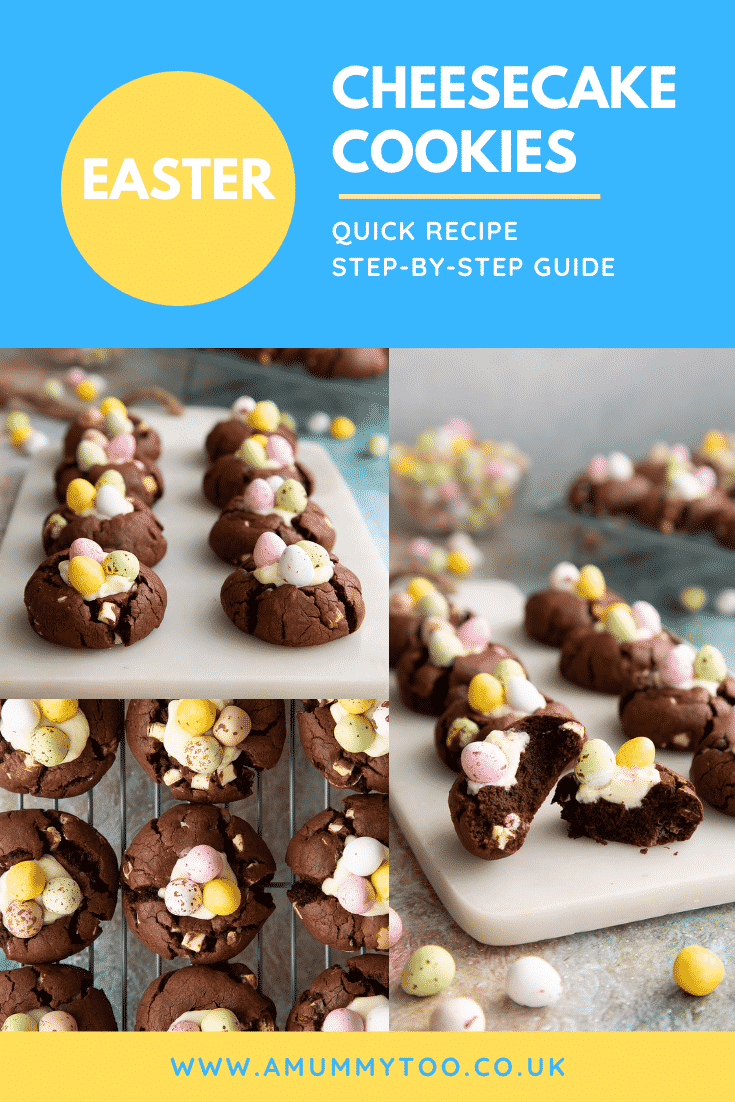
More Easter recipes to try
Have you got my book?

'This is a great kids cookery book. Emily is a star' - Simon Rimmer
'The book I'd like to force into any mother's kitchen' - Prue Leith
"A fab book with a plan." - Jane Devonshire, 2016 Masterchef UK winner
'Emily has managed to combine her mummy knowledge and passion for food to make a truly helpful and brilliant cookbook' - Priya Tew, RD, BSc (Hons), Msc
Get Your Kids to Eat Anything is an achievable 'how to' for parents in the battle to overcome picky eating and 'make new the norm'. Emily Leary's unique 5-phase programme looks at the issue of 'fussy eating' in a holistic way that links imagination with food, and which situates parents alongside - not in opposition to - their children.


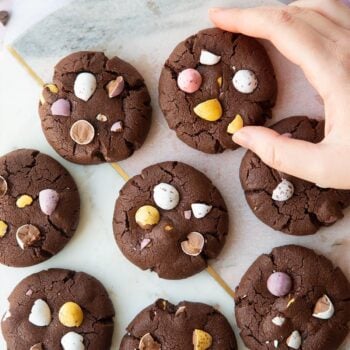
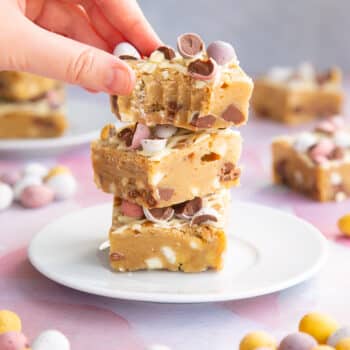
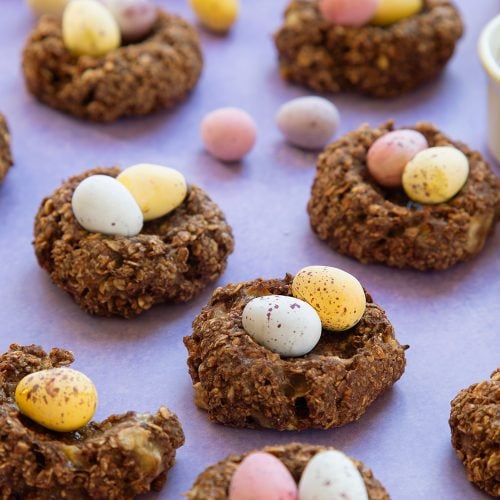
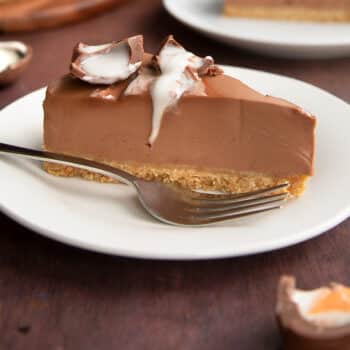
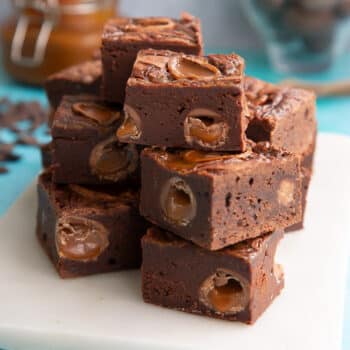
Leave a Reply